Music & Printed Scores
- Page 14 -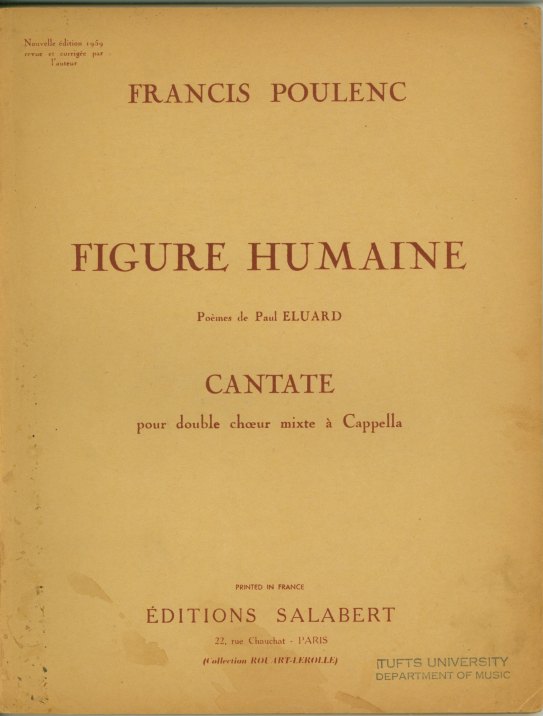 Poulenc, Francis (1899-1963) Figure Humaine; Poèmes de Paul Eluard. Cantates pour double choeur mixte à Cappella. Salabert: Paris, 1959. Nouvelle édition revue et corrigè par l'auteur. 82 pp. Full Score.MUS-12620 $35Inquire
Poulenc, Francis (1899-1963) Figure Humaine; Poèmes de Paul Eluard. Cantates pour double choeur mixte à Cappella. Salabert: Paris, 1959. Nouvelle édition revue et corrigè par l'auteur. 82 pp. Full Score.MUS-12620 $35Inquire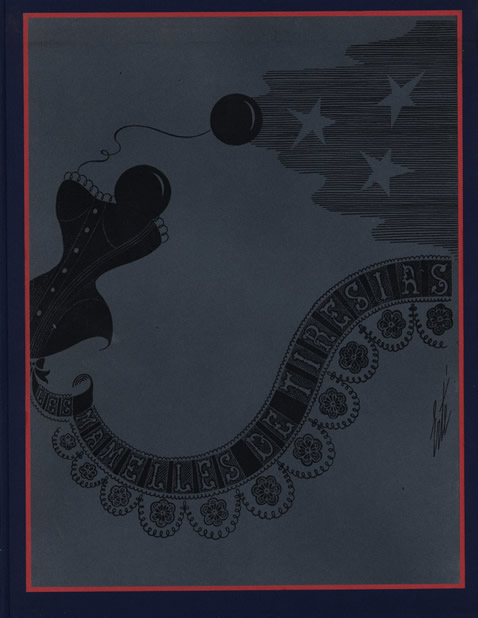 Poulenc, Francis (1899-1963) Les Mamelles de Tirésias. Piano Vocal Score Heugel: Paris Pl.n: Plate H31162. first edition. Large quarto. 139 pp. New cloth boards with facsimile of original cover on front and original covers bound in. Very slightly sprung but excellent otherwise.MUS-10854 $250InquireLes Mamelles de Tirésias, Poulenc's first opera, used as its libretto a 1905 Apollinaire play. Poulenc started it in 1939 but wrote it mostly during the summer of 1944 shortly before the end of World War II. The plot is about a wife who discards womanhood - her breats float away as two balloons - and whose husband takes on the role of childbearing, producing 40,000 babies per day. After the devastation of the war, Poulenc promoted the government's call to increase population with this burlesque opera, the chorus declaiming at the end: "Frenchmen, make babies!". The opera is dedicated to Poulenc's good friend the composer Darius Milhaud, to celebrate his return from the U.S.A. after the war. The premiere was given at the Opéra - Comique in Paris in June of 1947. The emminent Russian artist Erté, who designed the décor, also designed the title page of the score
Poulenc, Francis (1899-1963) Les Mamelles de Tirésias. Piano Vocal Score Heugel: Paris Pl.n: Plate H31162. first edition. Large quarto. 139 pp. New cloth boards with facsimile of original cover on front and original covers bound in. Very slightly sprung but excellent otherwise.MUS-10854 $250InquireLes Mamelles de Tirésias, Poulenc's first opera, used as its libretto a 1905 Apollinaire play. Poulenc started it in 1939 but wrote it mostly during the summer of 1944 shortly before the end of World War II. The plot is about a wife who discards womanhood - her breats float away as two balloons - and whose husband takes on the role of childbearing, producing 40,000 babies per day. After the devastation of the war, Poulenc promoted the government's call to increase population with this burlesque opera, the chorus declaiming at the end: "Frenchmen, make babies!". The opera is dedicated to Poulenc's good friend the composer Darius Milhaud, to celebrate his return from the U.S.A. after the war. The premiere was given at the Opéra - Comique in Paris in June of 1947. The emminent Russian artist Erté, who designed the décor, also designed the title page of the score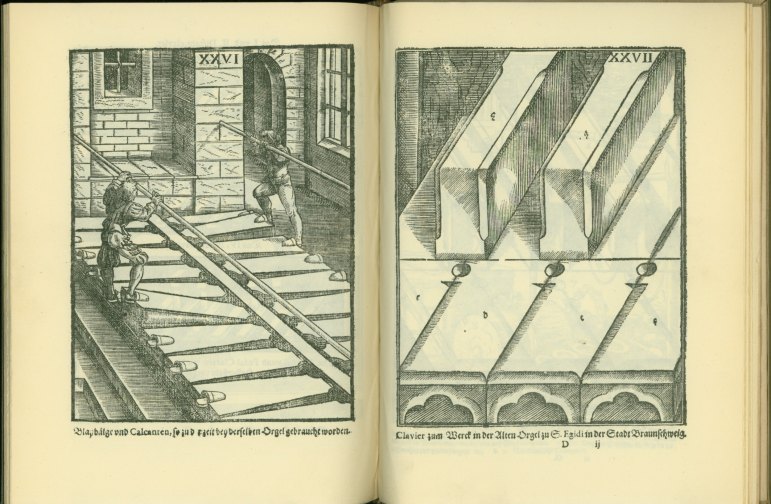 Praetorius, Michael Syntagmatis Musici Michaelis Praetorii c. Tomus Secundus de Organographia [Michael Praetorius: De Organographia zweiter teil des syntagma musicum] Wolfenbüttel, 1619 Im Bärenreiter-Verlag Zu Kassel: 1929. Quarto. 236 pp. + 42 pp. plates (including several foldout). Cream calf with 5 raised bands on spine in original slipcase. Excellent condition in original slipcase.FAC-13789 $135More Images/InquireFacsimile from the original dating 1619.
Praetorius, Michael Syntagmatis Musici Michaelis Praetorii c. Tomus Secundus de Organographia [Michael Praetorius: De Organographia zweiter teil des syntagma musicum] Wolfenbüttel, 1619 Im Bärenreiter-Verlag Zu Kassel: 1929. Quarto. 236 pp. + 42 pp. plates (including several foldout). Cream calf with 5 raised bands on spine in original slipcase. Excellent condition in original slipcase.FAC-13789 $135More Images/InquireFacsimile from the original dating 1619.- Prelleur, Peter (1705-1741) An Introduction to Singing, Peter Prelleur, the Modern Musick-Master Bärenreiter: London Quarto. 48 facsimile pp. Paper wraps. Fine. FAC-01171 $30Inquire
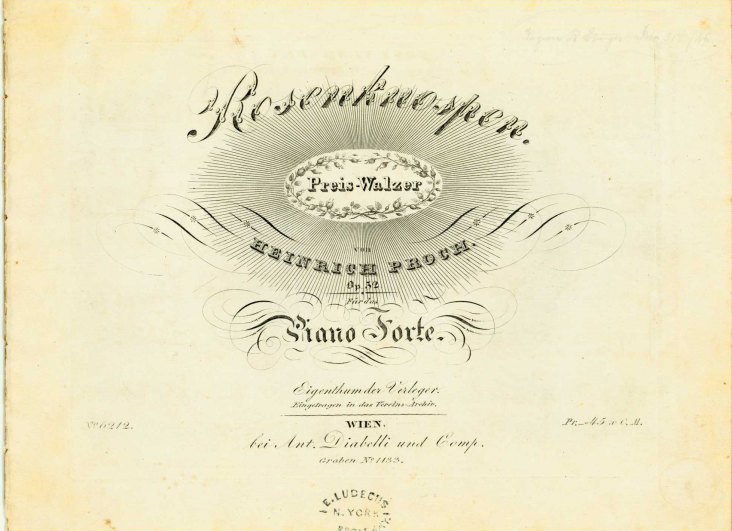 Proch, Heinrich (1809-1878) Rosenknospen. Preis-Walzer. Op. 32. Ant. Diabelli und Comp.: Vienna, [ca 1837]. Pl.n: D.et C.No.6212. Engraved. Oblong quarto. Disbound. A crisp copy in very good condition. Minor stains and dealer stamp to title page.MUS-07110 $25InquirePublished in or about 1837, based on plate number.
Proch, Heinrich (1809-1878) Rosenknospen. Preis-Walzer. Op. 32. Ant. Diabelli und Comp.: Vienna, [ca 1837]. Pl.n: D.et C.No.6212. Engraved. Oblong quarto. Disbound. A crisp copy in very good condition. Minor stains and dealer stamp to title page.MUS-07110 $25InquirePublished in or about 1837, based on plate number.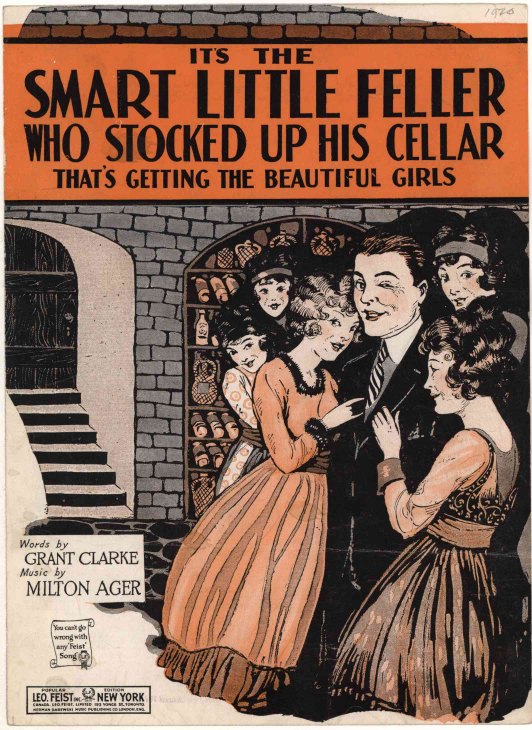 PROHIBITION SHEET MUSIC Six Songs about Prohibition. 1918-1930. Small quarto / Quarto. Illustrated color title pages. Group in excellent condition.MUS-15295 $125InquireFive Prohibition-era songs relating to the proposal, passage, and repeal of the Eighteenth Amendment, which greatly curtailed the public sale and consumption of alcohol in the United States from 1920 to 1933:
PROHIBITION SHEET MUSIC Six Songs about Prohibition. 1918-1930. Small quarto / Quarto. Illustrated color title pages. Group in excellent condition.MUS-15295 $125InquireFive Prohibition-era songs relating to the proposal, passage, and repeal of the Eighteenth Amendment, which greatly curtailed the public sale and consumption of alcohol in the United States from 1920 to 1933:"Every Day Will Be Sunday When The Town Goes Dry", by William Jerome and Jack Mahoney. Leo Feist: New York, 1918. 3 pp. Small quarto.
"How Are You Going to Wet Your Whistle When the Whole Darn World Goes Dry?", by Francis Byrne, Frank McIntyre, and Percy Wenrich. Leo Feist: New York, 1919. 3 pp. Small quarto.
"It's the Smart Little Feller Who Stocked Up His Cellar That's Getting the Beautiful Girls", by Grant Clarke and Milton Ager. Leo Feist: New York, 1920. 3 pp. Small quarto.
"Oh! Doctor", by Billy Joyce and Rubey Cowan. Stark & Cowan Music Publishers: New York, 1920. 3 pp. Small quarto.
"I'd Like to Find the Guy That Wrote the Stein Song", by Johnny Johnson and Harry McDaniel. Shapiro, Bernstein & Co.: New York, 1930. 5 pp. Quarto.
"Cocktails for Two", by Arthur Johnston and Sam Coslow. Famous Music: New York, 1934. 5 pp. Quarto.
The group represents a fascinating history of twentieth-century American prohibition from start to finish. "Everyday Will Be Sunday" and "How Are You Going to Wet Your Whistle" were published after the Senate proposed the Eighteenth Amendment in December 1917. As states gradually ratified it in the course of the following year, songs of the type reflected the concerns of those partygoers and revelers who feared the enforcement of its laws nationwide.Although the amendment passed in early 1919, it did not go into effect until January 1920. Affluent Americans used the interim year to stockpile wine, beer, and liquor for at-home consumption, which would remain permissible under the new laws. Even grape juice sales soared as people realized they could let it ferment and turn to wine. Songs like "It's the Smart Little Feller" amusingly noted the popularity of those individuals with an ample alcohol supply. Still, every stockpile began to wane sooner or later, and people began to exploit one of the amendment's loopholes by soliciting their doctors for prescriptions for hard liquor. "Oh! Doctor", one of the funnier songs in the group, reflects this popular practice.
"I'd Like to Find the Guy" is a parody song about a man who cannot bear to hear "The Maine Stein Song", a collegiate drinking tune, on the radio any longer. The top song of 1930, "The Maine Stein Song" was massively popular, but it was also criticized in some circles for being anti-prohibitionist.
The Eighteenth Amendment was repealed in December 1933. Its toll on the economy and agriculture, the difficulty of its enforcement alongside the rise of bootlegging, and the general lack of fun all contributed to its demise. Celebratory songs like "Cocktails for Two" reflected the widespread joy at the end of prohibition.
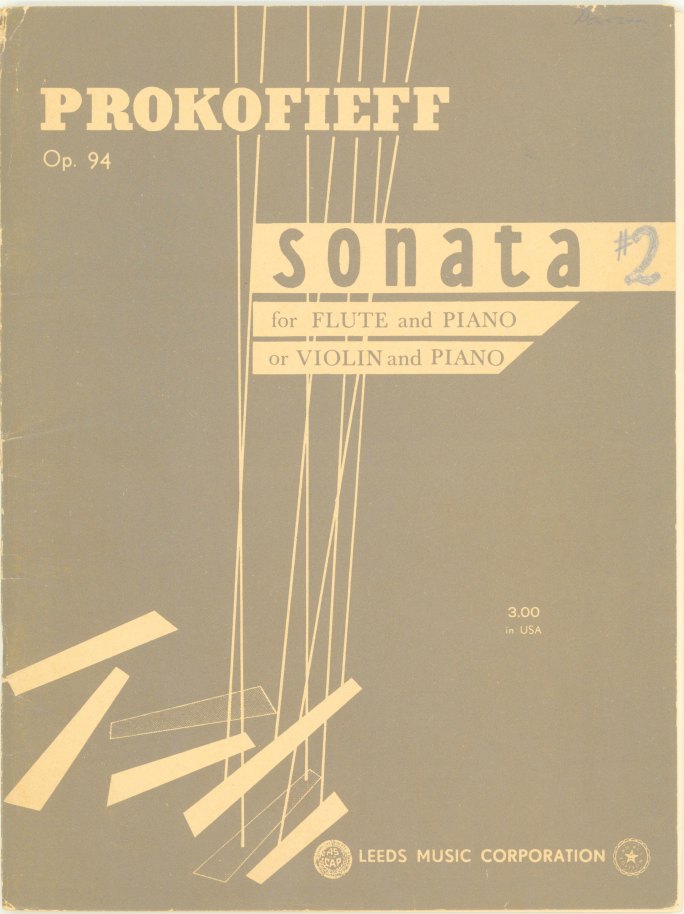 Prokofiev, Sergei (1892-1953) Sonata No. 2 for Flute and Piano or Violin and Piano. Op. 94. Edited with special annotations by Joseph Szigeti. Leeds Music Corporation: New York, 1946. Possible first edition. Quarto. 19 pp. [vln part] + 48 pp. [pno part]. Original paper wrappers (detaching at spine). On front cover, "#2" has been added in pencil in the work's title. Internally very clean and good.MUS-15120 $125InquireProkofiev requested that Joseph Szigeti, the editor of this volume, give the United States premiere of this sonata. The performance took place in Boston on November 26, 1944.
Prokofiev, Sergei (1892-1953) Sonata No. 2 for Flute and Piano or Violin and Piano. Op. 94. Edited with special annotations by Joseph Szigeti. Leeds Music Corporation: New York, 1946. Possible first edition. Quarto. 19 pp. [vln part] + 48 pp. [pno part]. Original paper wrappers (detaching at spine). On front cover, "#2" has been added in pencil in the work's title. Internally very clean and good.MUS-15120 $125InquireProkofiev requested that Joseph Szigeti, the editor of this volume, give the United States premiere of this sonata. The performance took place in Boston on November 26, 1944.This sonata was first published in 1946 by different publishers in London and New York (Boosey & Hawkes, Leeds Music Corporation, Anglo-Soviet Music Press), although it is difficult to determine which, if any, preceded the rest.
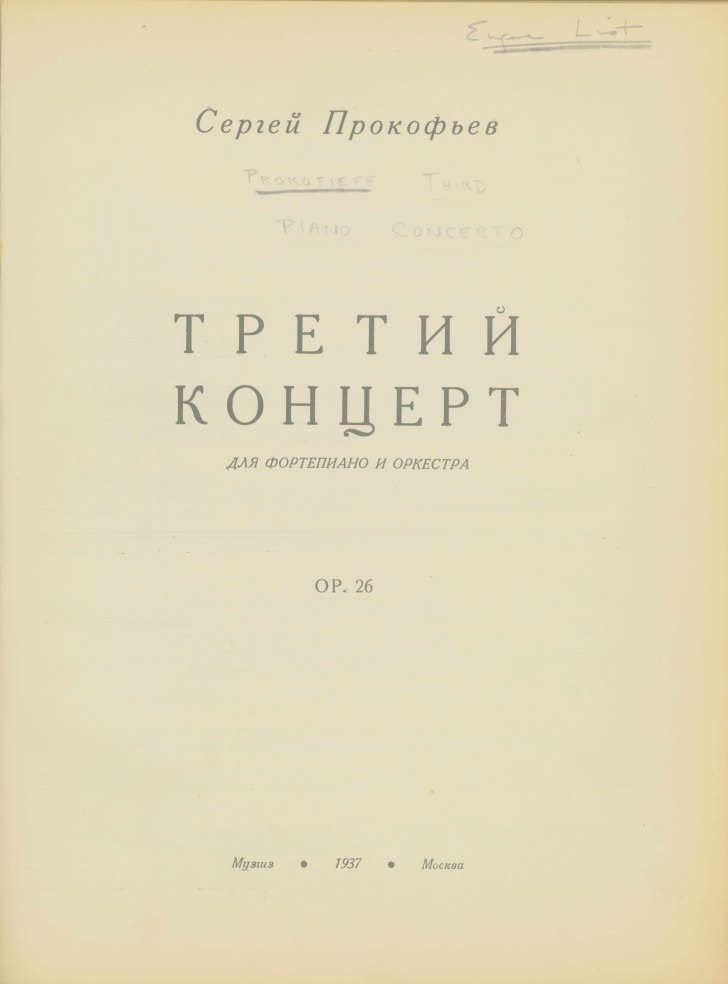 PROKOVIEV'S 3RD CONCERTO, A SPECIAL COPY Prokofiev, Sergei (1892-1953) Third Piano Concerto. Op. 26. Piano reduction. Signed "Eugene List" on the title page Moscow, 1937. first edition. Quarto. Green buckram boards. In excellent condition. Corners lightly bumped.MUS-14699 $375More Images/InquireFormerly the copy of American pianist Eugene List, with his copious pencil markings, including many fingerings, throughout the score, and signed by him in pencil on the title page.
PROKOVIEV'S 3RD CONCERTO, A SPECIAL COPY Prokofiev, Sergei (1892-1953) Third Piano Concerto. Op. 26. Piano reduction. Signed "Eugene List" on the title page Moscow, 1937. first edition. Quarto. Green buckram boards. In excellent condition. Corners lightly bumped.MUS-14699 $375More Images/InquireFormerly the copy of American pianist Eugene List, with his copious pencil markings, including many fingerings, throughout the score, and signed by him in pencil on the title page.Of Prokofiev's six piano concertos, the third is the most well known. The composer himself premiered it in Chicago in 1921; its melding of diatonicism and Russian folk tunes immediately appealed to the American audience. In 1932, the concerto became the first of Prokofiev's works to be recorded.
American pianist Eugene List's broad repertory included works both old and new. He first made a name for himself by giving the American premiere of Shostakovich's First Piano Concerto at 16, having been asked by Leopold Stokowski to perform it with only six weeks notice. His career flourished thereafter. He performed at the Potsdam Conference for Truman, Churchill, and Stalin, collaborated with his violinist wife, Caroll Glenn, and was instrumental in the revival of Louis Moreau Gottschalk's music.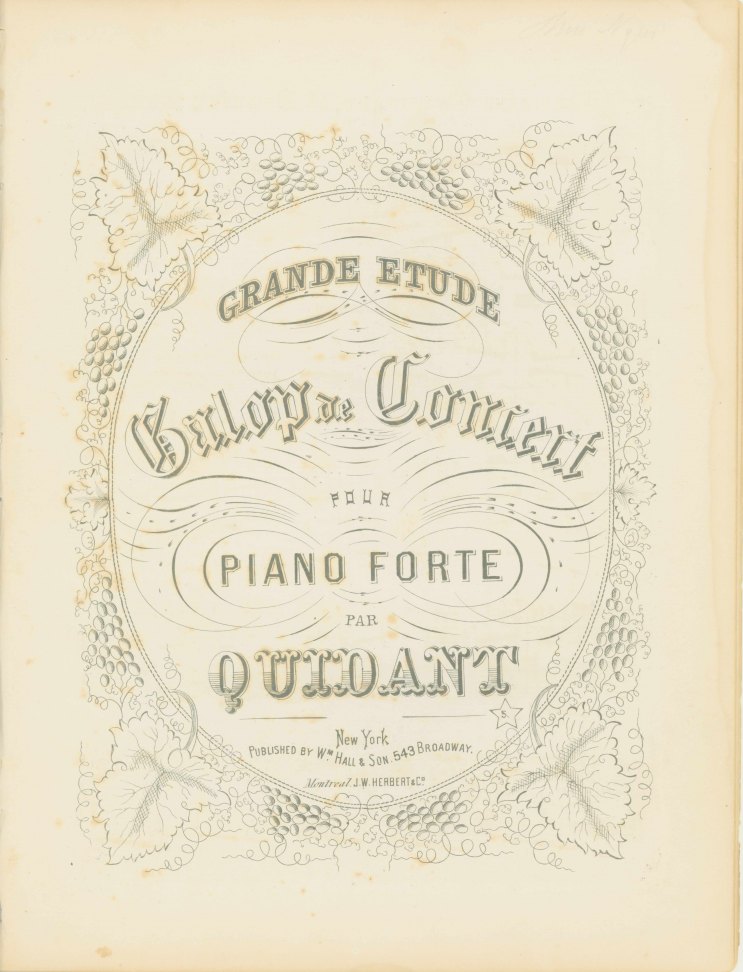 Quidant, P. R. J. (1815-1893) Grande Etude. Galop de Concert pour Piano Forte. [Tunes from Mazeppa]. William Hall & Son: New York, [1854]. Pl.n: 3016. Engraved. Quarto. 9 pp. Disbound and detaching. Water stain to right margin throughout (not affecting); ink transfer throughout. Pencilled pagination above printed pagination. Otherwise fine.MUS-14929 $25InquireEuropean editions of this piece note on the title page that its melodic material derives from Mazeppa. In this edition, there is a small note beneath the last stave on the first page: This Galop is known under the Title of MAZEPPA.
Quidant, P. R. J. (1815-1893) Grande Etude. Galop de Concert pour Piano Forte. [Tunes from Mazeppa]. William Hall & Son: New York, [1854]. Pl.n: 3016. Engraved. Quarto. 9 pp. Disbound and detaching. Water stain to right margin throughout (not affecting); ink transfer throughout. Pencilled pagination above printed pagination. Otherwise fine.MUS-14929 $25InquireEuropean editions of this piece note on the title page that its melodic material derives from Mazeppa. In this edition, there is a small note beneath the last stave on the first page: This Galop is known under the Title of MAZEPPA.Published in 1854, based on plate number.
- Rameau, Jean-Philippe (1683-1764) Traité de l'Harmonie réduite à les Principes naturels; divisé en quatre livres Broude Bros.: New York, 1965. Facsimile of the 1722 printed edition. Quarto. 432 facsimile pp. + 17-page supplement. Cloth boards. Fine. FAC-07563 $175InquireRameau's first and greatest theoretical work, with numerous music examples throughout, comprising four books in one volume with the last being a treatise on keyboard accompaniment.
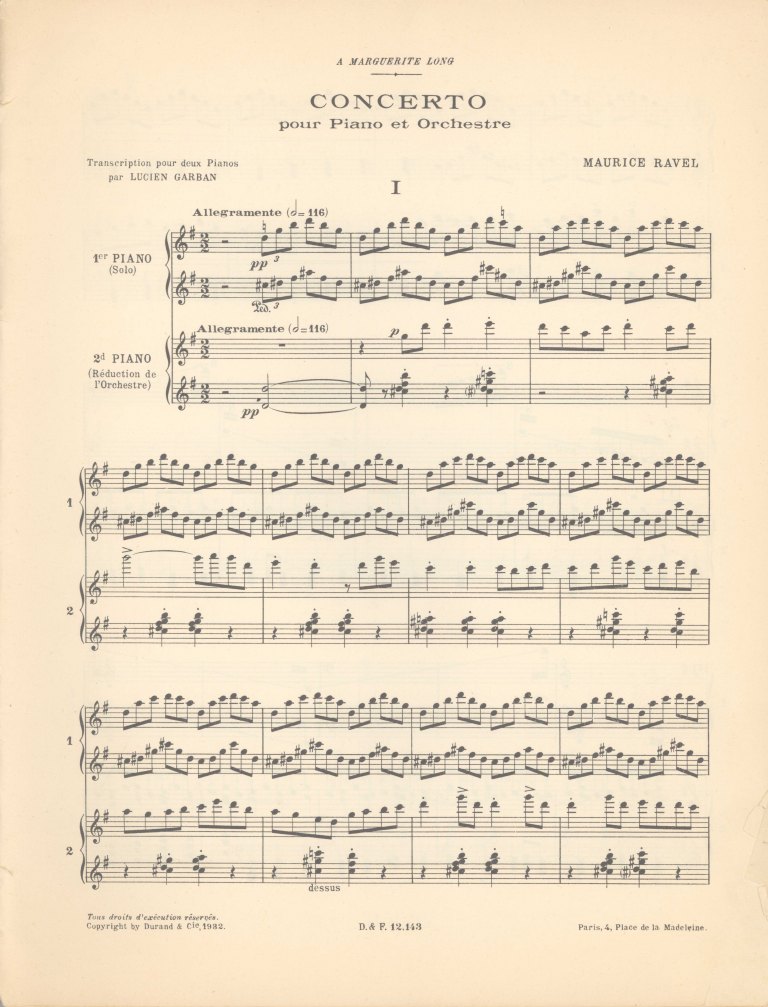 Ravel, Maurice (1875-1937) and Lucien Garban, arranger Concerto pour Piano et Orchestre. [Arrangement for Two Pianos]. Durand: Paris, 1932. Pl.n: D.&F. 12.143. Folio. 57 pp. Title page missing, upper left and lower right corners creased, last leaf chipped and tattered, but with no loss of music, otherwise good.MUS-10232 $40InquireSecond part in score (meaning, no separate second part).
Ravel, Maurice (1875-1937) and Lucien Garban, arranger Concerto pour Piano et Orchestre. [Arrangement for Two Pianos]. Durand: Paris, 1932. Pl.n: D.&F. 12.143. Folio. 57 pp. Title page missing, upper left and lower right corners creased, last leaf chipped and tattered, but with no loss of music, otherwise good.MUS-10232 $40InquireSecond part in score (meaning, no separate second part).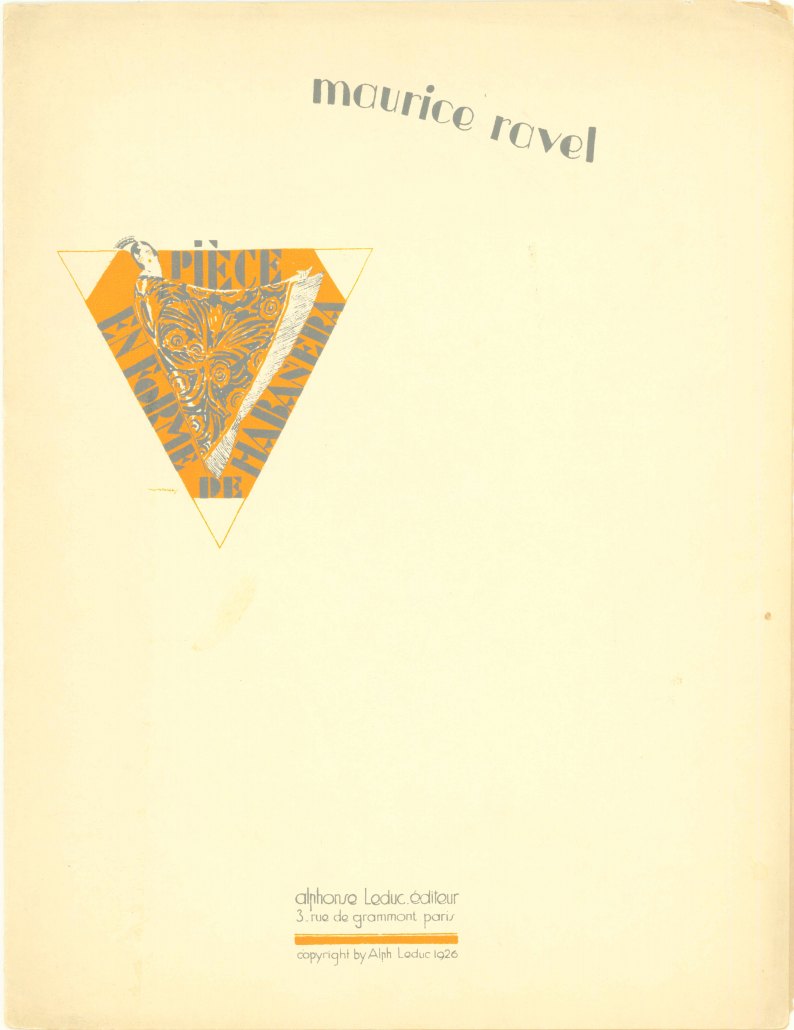 Ravel, Maurice (1875-1937) and Paul Bazelaire, transcription Pièce en Forme de Habanera. Alphonse Leduc: Paris, 1926. Pl.n: A. L. 16,1712. Large quarto. 1 p. [cello part] + 4 pp. [piano part]. Original covers. A few chips and minor tears to margins. Pages quite toned, but very clean and in good condition.MUS-07114 $25Inquire
Ravel, Maurice (1875-1937) and Paul Bazelaire, transcription Pièce en Forme de Habanera. Alphonse Leduc: Paris, 1926. Pl.n: A. L. 16,1712. Large quarto. 1 p. [cello part] + 4 pp. [piano part]. Original covers. A few chips and minor tears to margins. Pages quite toned, but very clean and in good condition.MUS-07114 $25Inquire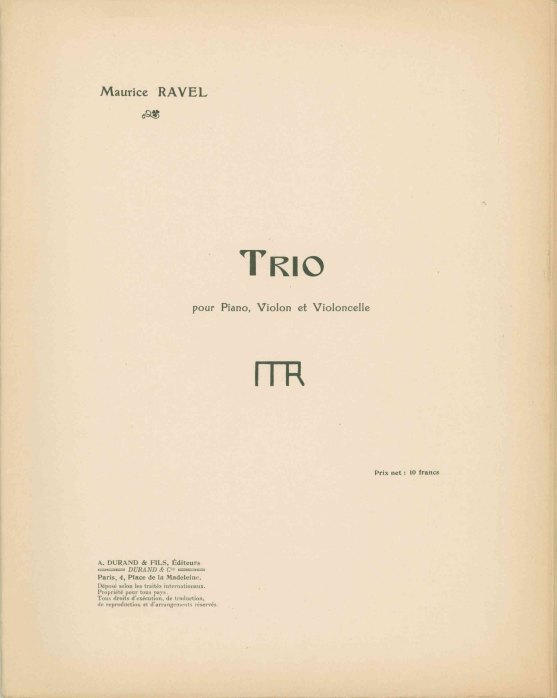 Ravel, Maurice (1875-1937) Trio pour Piano, Violon et Violoncelle. Durand & Cie.: Paris, 1915. Pl.n: D. & F. 9346. first edition. Quarto. 35 pp. [pno score]; 11 pp. [vln]; 12 pp. [vlc]. Original brown paper wraps. A very good, clean copy. Front wrapper with dealer stamp and signature of former owner.MUS-15545 $145InquirePiano score and parts.
Ravel, Maurice (1875-1937) Trio pour Piano, Violon et Violoncelle. Durand & Cie.: Paris, 1915. Pl.n: D. & F. 9346. first edition. Quarto. 35 pp. [pno score]; 11 pp. [vln]; 12 pp. [vlc]. Original brown paper wraps. A very good, clean copy. Front wrapper with dealer stamp and signature of former owner.MUS-15545 $145InquirePiano score and parts.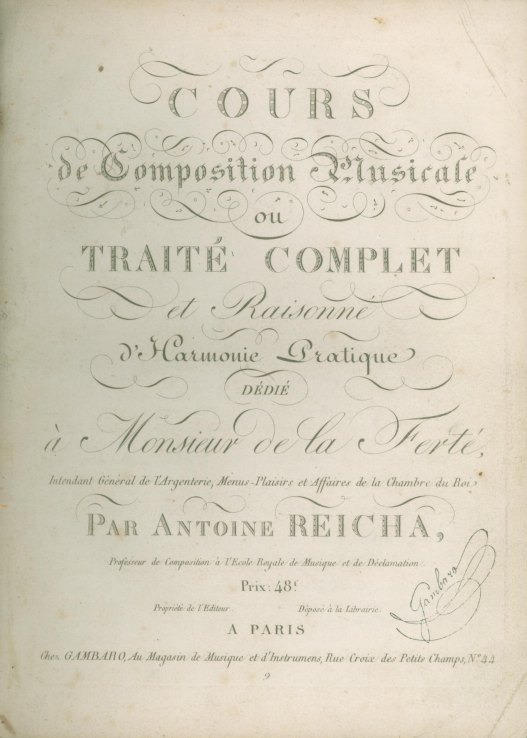 Reicha, Anton (1770-1836) Cours de Composition Musicale ou Traité Complet et Raisonné d'Harmonie Pratique. Chez Gambaro: Paris, [1818]. first edition. Engraved. Quarto. 269 pp. Contemporary green paper boards. A desirable copy in very good, clean condition internally. Title page a bit dusty and creased; only very minor spotting thereafter. Boards worn and front detaching; backstrip missing. With the publisher's stamp on the title page.MTH-14678 $200More Images/InquireAlthough a prolific composer, Reicha made his greatest contributions as a theorist and teacher. He wrote this harmony method in 1818, shortly after being appointed professor of counterpoint and fugue at the Paris Conservatoire. It is among the first textbooks to use examples written expressly for the text (rather than preexisting music) and became a fixture in the school's curriculum.
Reicha, Anton (1770-1836) Cours de Composition Musicale ou Traité Complet et Raisonné d'Harmonie Pratique. Chez Gambaro: Paris, [1818]. first edition. Engraved. Quarto. 269 pp. Contemporary green paper boards. A desirable copy in very good, clean condition internally. Title page a bit dusty and creased; only very minor spotting thereafter. Boards worn and front detaching; backstrip missing. With the publisher's stamp on the title page.MTH-14678 $200More Images/InquireAlthough a prolific composer, Reicha made his greatest contributions as a theorist and teacher. He wrote this harmony method in 1818, shortly after being appointed professor of counterpoint and fugue at the Paris Conservatoire. It is among the first textbooks to use examples written expressly for the text (rather than preexisting music) and became a fixture in the school's curriculum.As per Grove's Dictionary, the treatise stresses the point that theory must be justified by practice and that the pupil must learn about contemporary usage, not solely about ancient principles.
Reicha was a lifelong friend of Beethoven and his pupils included Liszt, Berlioz, and Ceasar Frank.- Reichardt, Johann Friedrich (1752-1814) Goethes Lieder, Oden Balladen und Romanzen. Facsimile of the printed score Breitkopf & Härtel: Leipzig, 1969. Oblong quarto. 29 facsimile pp. Cloth. Fine. FAC-08226 $100Inquire
 Reissinger, G. Variationen für das Piano-Forte über ein Thema der Arie (Durch die Waelder) aus der Oper Der Freyschütze. Op. 12. Artaria und Comp.: Vienna, [c 1822]. Pl.n: 2667. Engraved. Oblong quarto. 9 pp. Title page stained, outer pages detaching, and edges rumpled with minor tears, but music quite clean.MUS-07119 $50InquirePublished in or about 1822, based on plate number.
Reissinger, G. Variationen für das Piano-Forte über ein Thema der Arie (Durch die Waelder) aus der Oper Der Freyschütze. Op. 12. Artaria und Comp.: Vienna, [c 1822]. Pl.n: 2667. Engraved. Oblong quarto. 9 pp. Title page stained, outer pages detaching, and edges rumpled with minor tears, but music quite clean.MUS-07119 $50InquirePublished in or about 1822, based on plate number.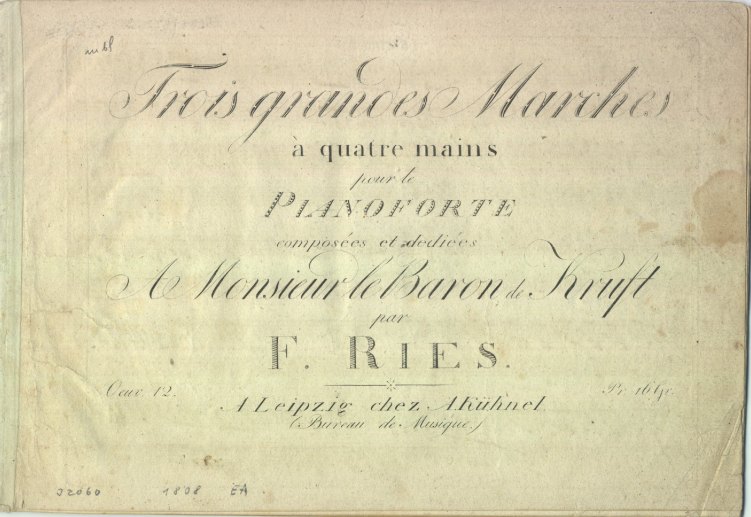 Ries, Ferdinand (1784-1838) Trois grandes Marches à quatre mains pour le Pianoforte composàes et dediàes A Monsieur le Baron de. Kruft par F. Ries. Oeuv. 12 Kühnel: Leipzig, [1808]. Pl.n: 698. first edition. Oblong quarto. 15 pp. Disbound. Soiling and light stain on title page, soiling at lower right corner from use, otherwise very good.MUS-10215 $125Inquire
Ries, Ferdinand (1784-1838) Trois grandes Marches à quatre mains pour le Pianoforte composàes et dediàes A Monsieur le Baron de. Kruft par F. Ries. Oeuv. 12 Kühnel: Leipzig, [1808]. Pl.n: 698. first edition. Oblong quarto. 15 pp. Disbound. Soiling and light stain on title page, soiling at lower right corner from use, otherwise very good.MUS-10215 $125Inquire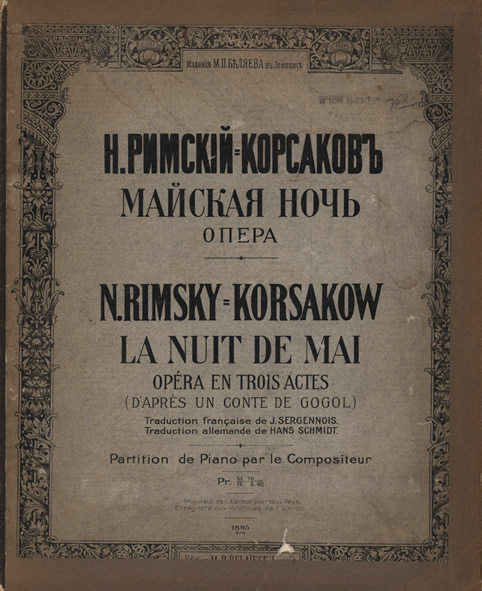 Rimsky-Korsakov, Nikolai (1844-1908) La Nuit de Mai, Opéra en 3 Acts (D'Après un Conte de Gogol). Piano Vocal Score Belaieff: Leipzig, 1895. Large quarto. 260 pp. with original full-color Russian title page. Paper wraps with black linen spine. Interior overall very good with a few pages stained at edges. Covers a bit ratty with reinforcements on all edges and spine torn at top and bottom.MUS-10850 $175InquireThis copy formerly owned by Adolph Bolm with his stamp on the interior pages. Bolm was a choreographer and dancer with Mariinsky Ballet. He was also the choreographer for the 1914 performance of La Nuit de Mai with the Ballets Russes.
Rimsky-Korsakov, Nikolai (1844-1908) La Nuit de Mai, Opéra en 3 Acts (D'Après un Conte de Gogol). Piano Vocal Score Belaieff: Leipzig, 1895. Large quarto. 260 pp. with original full-color Russian title page. Paper wraps with black linen spine. Interior overall very good with a few pages stained at edges. Covers a bit ratty with reinforcements on all edges and spine torn at top and bottom.MUS-10850 $175InquireThis copy formerly owned by Adolph Bolm with his stamp on the interior pages. Bolm was a choreographer and dancer with Mariinsky Ballet. He was also the choreographer for the 1914 performance of La Nuit de Mai with the Ballets Russes.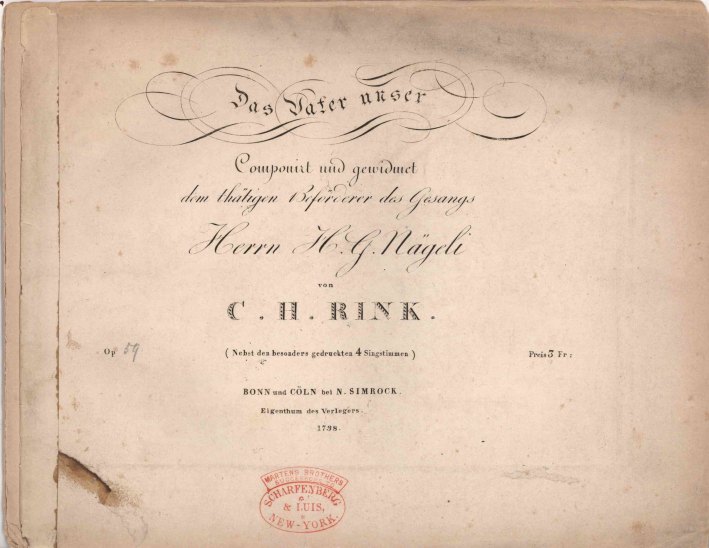 Rinck, Christian Heinrich (1770-1846) Das Vater unser. Nebst den besonders gedruckten 4 Singstimmen. Op. 59. N. Simrock: Bonn / Cöln, [c 1820, as per plate number and WorldCat]. Pl.n: 1738. Engraved. Oblong quarto. Disbound. Individual parts and final page detached. Detached title page a bit dusty with repaired tear at side and dealer stamp at bottom. Music clean with occasional dealer stamp at margins. Back page with some minor tears. On the whole a good copy.MUS-15264 $35InquireThis volume includes four separate detached parts (one each for soprano, alto, tenor, and bass) and a score with organ accompaniment. The parts are oriented vertically and the score horizontally.Christian Heinrich Rinck was a German organist, composer, and celebrated teacher. He wrote primarily for organ and was selected by Schott to prepare the first piano version of Beethoven's Missa Solemnis. Rinck's library was given to Yale University.
Rinck, Christian Heinrich (1770-1846) Das Vater unser. Nebst den besonders gedruckten 4 Singstimmen. Op. 59. N. Simrock: Bonn / Cöln, [c 1820, as per plate number and WorldCat]. Pl.n: 1738. Engraved. Oblong quarto. Disbound. Individual parts and final page detached. Detached title page a bit dusty with repaired tear at side and dealer stamp at bottom. Music clean with occasional dealer stamp at margins. Back page with some minor tears. On the whole a good copy.MUS-15264 $35InquireThis volume includes four separate detached parts (one each for soprano, alto, tenor, and bass) and a score with organ accompaniment. The parts are oriented vertically and the score horizontally.Christian Heinrich Rinck was a German organist, composer, and celebrated teacher. He wrote primarily for organ and was selected by Schott to prepare the first piano version of Beethoven's Missa Solemnis. Rinck's library was given to Yale University.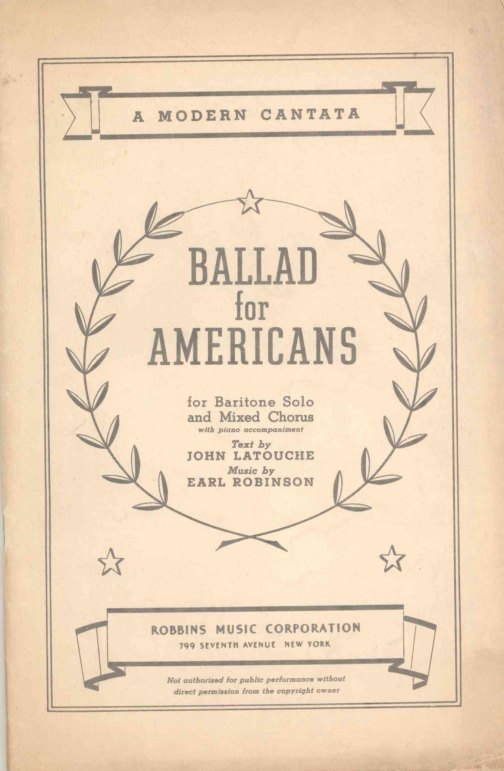 Robinson, Earl (1910-1991) A Modern Cantata: Ballad for Americans for Baritone Solo and Mixed Chorus Robbins Music Corporation: New York, 1940. Pl.n: SH 1975-42. first edition. Small quarto. 43 pp. Paper wraps. In excellent condition. Covers a bit dusty and a few penciled performance notes throughout.MUS-12824 $100InquireEarl Robinson wrote the "Ballad for Americans" for a 1939 production of Sing for Your Supper funded by the Federal Theatre Project (part of the Works Progress Administration). It quickly became Robinson's most popular composition and was performed and recorded by such diverse artists as Paul Robeson, Bing Crosby, Lawrence Tibbett, and Odetta.Robinson was a composer, arranger, and folk music singer-songwriter. In the 1940s he worked on film scores in Hollywood until he was blacklisted for being a Communist.
Robinson, Earl (1910-1991) A Modern Cantata: Ballad for Americans for Baritone Solo and Mixed Chorus Robbins Music Corporation: New York, 1940. Pl.n: SH 1975-42. first edition. Small quarto. 43 pp. Paper wraps. In excellent condition. Covers a bit dusty and a few penciled performance notes throughout.MUS-12824 $100InquireEarl Robinson wrote the "Ballad for Americans" for a 1939 production of Sing for Your Supper funded by the Federal Theatre Project (part of the Works Progress Administration). It quickly became Robinson's most popular composition and was performed and recorded by such diverse artists as Paul Robeson, Bing Crosby, Lawrence Tibbett, and Odetta.Robinson was a composer, arranger, and folk music singer-songwriter. In the 1940s he worked on film scores in Hollywood until he was blacklisted for being a Communist. Rochberg, George (1918-2005) Symphony No. 2 Theodore Presser Company: Bryn Mawr, Pennsylvania, 1961. Apparent first edition. Small quarto. 164 pp. Gray paper wraps. Faint coffee cup stain and publisher's stamp on cover. Otherwise very good.SSC-05799 $250InquireInscribed on title page by the composer: For Gene Bruck | with warmest wishes | George.Rochberg composed this symphony between 1955 and 1956, shortly after committing himself to Schoenberg's serial technique, which he believed a necessary and unavoidable development in musical composition. Scholars count this work among the first in which Rochberg mastered his own serial style.
Rochberg, George (1918-2005) Symphony No. 2 Theodore Presser Company: Bryn Mawr, Pennsylvania, 1961. Apparent first edition. Small quarto. 164 pp. Gray paper wraps. Faint coffee cup stain and publisher's stamp on cover. Otherwise very good.SSC-05799 $250InquireInscribed on title page by the composer: For Gene Bruck | with warmest wishes | George.Rochberg composed this symphony between 1955 and 1956, shortly after committing himself to Schoenberg's serial technique, which he believed a necessary and unavoidable development in musical composition. Scholars count this work among the first in which Rochberg mastered his own serial style.![Rodgers, Richard - Oklahoma! [piano/vocal score].](/images/web/MUS/rodgers-mus-15837.jpg) Rodgers, Richard (1902-1979) and Oscar Hammerstein II Oklahoma! [piano/vocal score]. Williamson Music Inc.: New York, 1943. Pl.n: C-523. first edition. Quarto. 208 pp. Original paper wraps. Music clean and in excellent condition. Wrappers detaching with small piece of tape inside front at spine.MUS-15837 $350InquireThis first edition was published shortly after the musical's premiere in New York on March 31, 1943. Pearl Harbor had occurred only 16 months before and success was not at all secure. However, after World War II and the Depression, the public was in a nostalgic mood and the show would run for an unprecedented 2,212 performances. Oklahoma as a state was only 36 years old and perhaps that reminded people of their pioneer past and the possibility of a brighter future.
Rodgers, Richard (1902-1979) and Oscar Hammerstein II Oklahoma! [piano/vocal score]. Williamson Music Inc.: New York, 1943. Pl.n: C-523. first edition. Quarto. 208 pp. Original paper wraps. Music clean and in excellent condition. Wrappers detaching with small piece of tape inside front at spine.MUS-15837 $350InquireThis first edition was published shortly after the musical's premiere in New York on March 31, 1943. Pearl Harbor had occurred only 16 months before and success was not at all secure. However, after World War II and the Depression, the public was in a nostalgic mood and the show would run for an unprecedented 2,212 performances. Oklahoma as a state was only 36 years old and perhaps that reminded people of their pioneer past and the possibility of a brighter future.“Oklahoma!” was Richard Rodgers’ first collaboration without his longtime partner Larry Hart and his first with Oscar Hammerstein II, with whom he would go on to write South Pacific, The Sound of Music, The King and I and Carousel. Another new element was the inclusion of Agnes De Mille’s choreography. Oklahoma! contains some of the most recognizable song hits of all time, including "Oh, What A Beautiful Mornin", "The Surrey with the Fringe on Top", "I Cain't Say No", "People Will Say We're in Love", and "Pore Jud Is Daid".
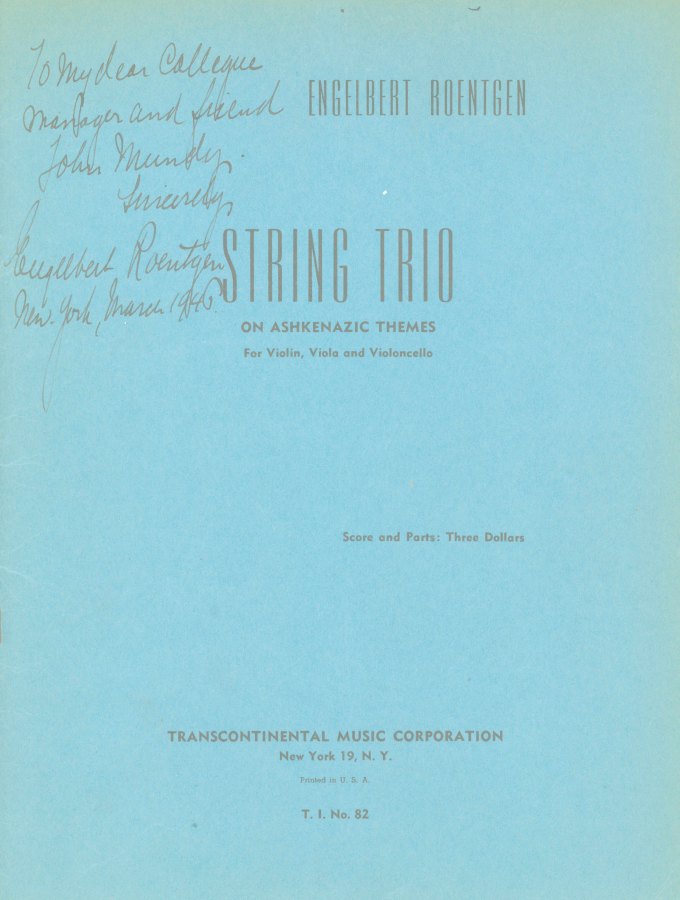 Roentgen, Engelbert (1829-1897) String Trio on Ashkenazic Themes. For Violin, Viola, and Violoncello. Transcontinental Music Corporation: New York, 1946. Quarto. 15 pp, full score with parts. Blue paper wraps. In excellent condition.SSC-15075 $50InquireEngelbert Roentgen was the father of his better-known composer son, Julius Roentgen. This edition of the elder Roentgen's String Trio is signed and inscribed by his namesake grandson (Julius's son), a talented cellist who studied with Casals and played in the Metropolitan Opera Orchestra.
Roentgen, Engelbert (1829-1897) String Trio on Ashkenazic Themes. For Violin, Viola, and Violoncello. Transcontinental Music Corporation: New York, 1946. Quarto. 15 pp, full score with parts. Blue paper wraps. In excellent condition.SSC-15075 $50InquireEngelbert Roentgen was the father of his better-known composer son, Julius Roentgen. This edition of the elder Roentgen's String Trio is signed and inscribed by his namesake grandson (Julius's son), a talented cellist who studied with Casals and played in the Metropolitan Opera Orchestra.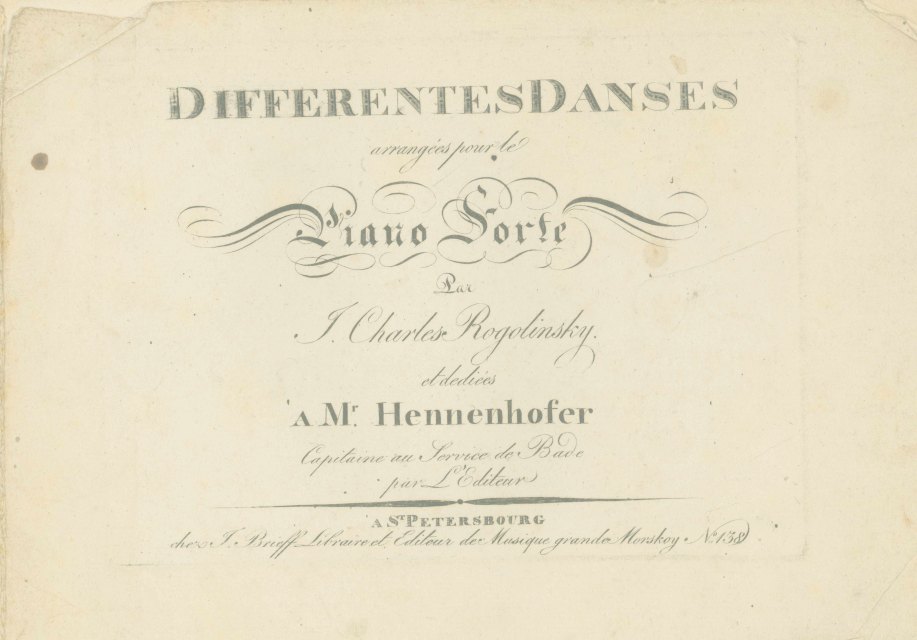 ROGOLINSKY - DANCES FOR PIANO Rogolinsky, J. Charles (?-c. 1840) Differentes Danses, arrangées pour le Piano Forte. J. Brieff: St. Petersburg, Russia, [n/d]. Engraved. Oblong quarto. 4 pp. Title page quite worn and corners creased throughout. Internally clean with very minor ink transfer.MUS-14960 $100More Images/InquireAn uncommon edition. Very little is known about J. Charles Rogolinsky. These dances are quite representative of his few extant publications, all of which are light compositions for keyboard.
ROGOLINSKY - DANCES FOR PIANO Rogolinsky, J. Charles (?-c. 1840) Differentes Danses, arrangées pour le Piano Forte. J. Brieff: St. Petersburg, Russia, [n/d]. Engraved. Oblong quarto. 4 pp. Title page quite worn and corners creased throughout. Internally clean with very minor ink transfer.MUS-14960 $100More Images/InquireAn uncommon edition. Very little is known about J. Charles Rogolinsky. These dances are quite representative of his few extant publications, all of which are light compositions for keyboard.Only slightly more can be said about the publisher, J. Brieff. He seems to have been in operation by 1810 at the latest, and conducted at least some business with the publishing firm Paez, which was also based in St. Petersburg during the first half of the nineteenth century.
Sold together with two additional and different sets of dances:
Rogolinsky, Charles. Recueil de differentes Danses Pour le Piano Forte. J. Brieff: St. Petersbourg, Russia, n/d. Engraved. Oblong quarto. 9 pp. Title page vignette. Title page beginning to detach. A little ink transfer. Otherwise clean and good.Rogolinsky, Charles. Recueil de differentes Danses Pour le Piano Forte. Vonderfour: St. Petersburg, Russia, n/d. Pl.n. 39. Engraved. Oblong quarto. 13 pp. Title page a little dusty. Some ink transfer throughout, but otherwise excellent.
- Romberg, Andreas (1767-1821) and Bernard ROMBERG (1767-1841) [Six Symphonies and Seven Overtures by Andreas and Bernard Romberg, arranged for Two Violins, Flute, Viola and Cello, with an additional Bass or Piano ad lib.] London Folio. Six complete parts, each separately bound in durable blue buckram. A few nicely repaired corners, otherwise very good. MUS-07346 $550InquireCONTENTS:
- [Symphonies, arranged] Nos. 1.2.3. Grand Symphonies Composed by A. Romberg, Adapted for Two Violins, Flute, Tenor & Violoncello, With an additional Bass or Piano Forte (Ad libitum) by G. Masi (London: R. Cocks, [after 1845]. Plate number 4427, 21+21+20+11+20+35 pp.).
- [Symphonies, arranged] No. 4.5.6. Grand Symphonies, Composed by Andreas, & Bernard Romberg, adapted for Two Violins, Flute, Tenor & Violoncello, with an Additional Bass, or Piano Forte (ad libitum) by H. Hill (London: Monzani & Hill, [c. 1818-29]. Plate number "Rombergs Syms. 2d. Set.", 27+22+19+17+19+39 pp.).
- [Overtures, arranged] Nos. 1 & 2. B. Romberg's Celebrated Overture, Op. 11, in D Major, and Ditto Op. 26, to Ulysse et Circe, Adapted for Two Violins, Flute, Alto, Violoncello, Contra Basso, & Piano Forte, by G. Masi. 1st Set (London: R. Cocks, [1823-44]. Plate number 4424, 5+5+5+5+5+9 pp.).
- [Overtures, arranged] No. 3.4.5. Grand Overtures, composed by A. Romberg, as Performed at the Concerts of the Philharmonic Society, Adapted for Two Violins, Flute, Tenor, & Violoncello, with an additional Bass or Piano Forte, by H. Hill (London: R. Cocks, [after 1845]. Plate number 4425, 11+9+7+7+8+15 pp.).
- [Overtures, arranged] Nos. 6.7. A. Romberg's Grand Overture, to Le Rovine di Palluzzi, and B. Romberg's Grand Concert Overture, Adapted for Two Violins, Flute, Tenor, Violoncello, and Bass or Piano Forte, by H. Hill. 3d. Set (London: R. Cocks, [1823-44]. Plate number 4426, 8+7+6+5+7+10 pp.). 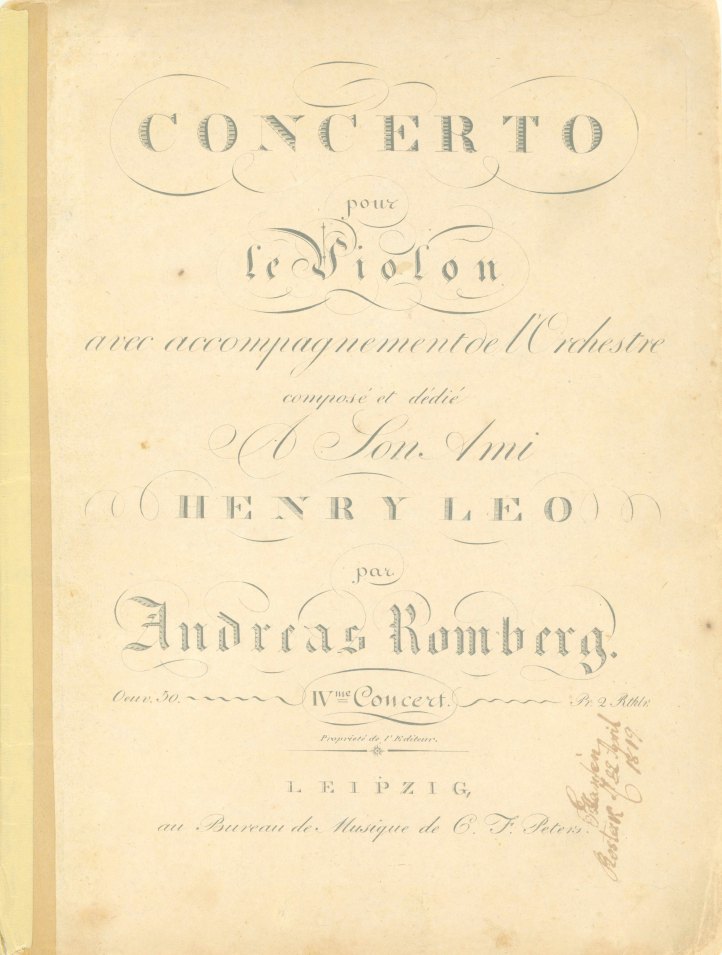 Romberg, Andreas (1767-1821) Concerto pour le Violon, avec accompagnement de l'Orchestre. Ivme Concert. Op. 50. Bureau de Musique de C. F. Peters: Leipzig, [c 1819]. Pl.n: 1360. Engraved. Likely first edition. Quarto. 15 pp. Disbound with two layers of paper tape reinforcement at spine. A nice copy in very good condition. Some minor stains and signature of former owner on cover, dated 1819.MUS-06439 $60InquireViolin part only.
Romberg, Andreas (1767-1821) Concerto pour le Violon, avec accompagnement de l'Orchestre. Ivme Concert. Op. 50. Bureau de Musique de C. F. Peters: Leipzig, [c 1819]. Pl.n: 1360. Engraved. Likely first edition. Quarto. 15 pp. Disbound with two layers of paper tape reinforcement at spine. A nice copy in very good condition. Some minor stains and signature of former owner on cover, dated 1819.MUS-06439 $60InquireViolin part only.Although Romberg composed twenty violin concertos, only four were published.
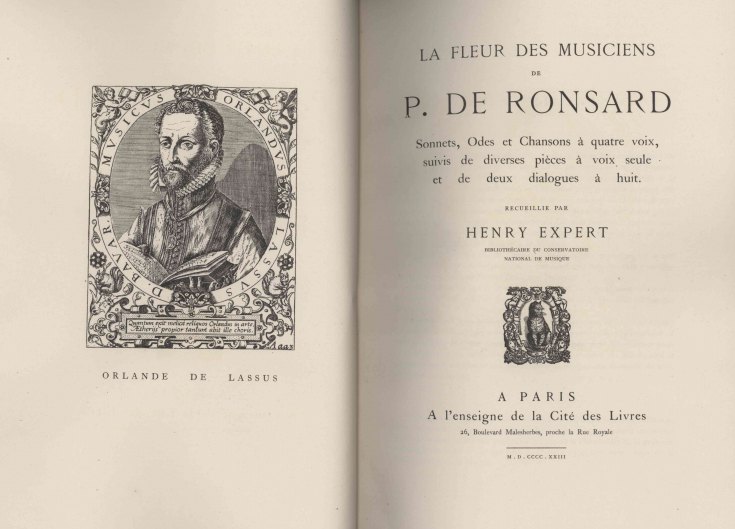 Ronsard, Pierre de (1524-1585) La Fleur des Musiciens de P. de Ronsard. Henry Expert, ed. A l'enseigne de la Cité des Livres: Paris, 1923. An (unnumbered) copy of a limited issue of 1,050 on vélin d'arches. Quarto. 104 pp. Frontispiece portrait of Orlando di Lasso. Quarter-bound navy-blue leather with marbled paper boards. Raised bands and gilt title at spine. Original deckled edges. In excellent condition (spine ever so slightly rubbed).MUS-14634 $200More Images/InquireA beautifully presented collection of Renaissance vocal music in modern notation, all of which sets texts by the French poet Pierre de Ronsard. Composers represented include: Pierre Certon, Guillaume Costeley, Claude Goudimel, Clement Janequin, Nicolas de la Grotte, Orlande de Lassus, François Regnard, and Jehan Chardavoine.
Ronsard, Pierre de (1524-1585) La Fleur des Musiciens de P. de Ronsard. Henry Expert, ed. A l'enseigne de la Cité des Livres: Paris, 1923. An (unnumbered) copy of a limited issue of 1,050 on vélin d'arches. Quarto. 104 pp. Frontispiece portrait of Orlando di Lasso. Quarter-bound navy-blue leather with marbled paper boards. Raised bands and gilt title at spine. Original deckled edges. In excellent condition (spine ever so slightly rubbed).MUS-14634 $200More Images/InquireA beautifully presented collection of Renaissance vocal music in modern notation, all of which sets texts by the French poet Pierre de Ronsard. Composers represented include: Pierre Certon, Guillaume Costeley, Claude Goudimel, Clement Janequin, Nicolas de la Grotte, Orlande de Lassus, François Regnard, and Jehan Chardavoine.- Ross, John (1763-1837) Three Sonatas for the Piano Forte, with an Accompaniment for the Violin or German Flute, Op. 6. For the subjects of the Slow Movements, some favorite Scotish Airs are Introduced Preston: London, [c 1795]. Pl.n: n.p.n. Folio. 39 pp. Disbound. A few pages with bent corners and small tears, title page and last page almost detached, a few faint pencil fingerings and ornaments, otherwise very good. MUS-07131 $150InquirePiano part only. Violin/flute part cued in occasionally in the third sonata.
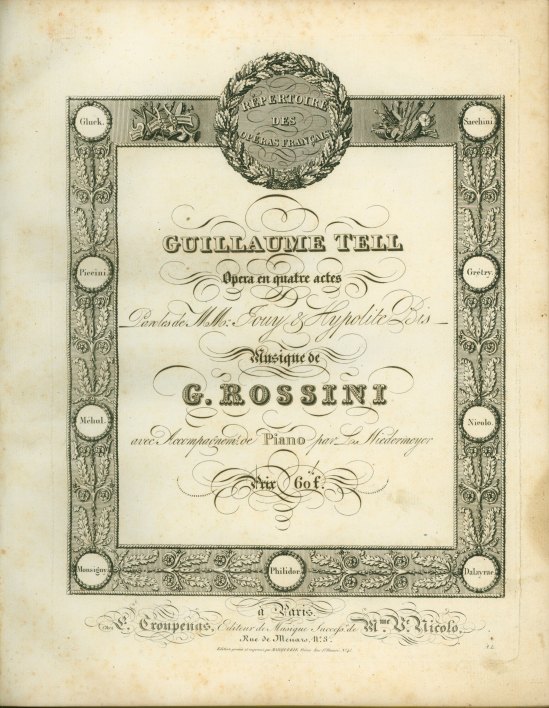 Rossini, Gioacchino (1792-1868) Guillaume Tell, Opéra en Quatre Actes (Piano/Vocal Score).MUS-13806 $450Inquire
Rossini, Gioacchino (1792-1868) Guillaume Tell, Opéra en Quatre Actes (Piano/Vocal Score).MUS-13806 $450Inquire
Paroles MM. Jouy and Hypolite Bis avec accompanment de Piano par L. Niedermeyer Troupenas: Paris, 1829. Pl.n: 329. Price: 60f. first edition. Large Quarto. 396 pp. Half-leather with green buckram boards, spine with gold bands. Internally excellent and crisp (with very minor occasional foxing). Binding scuffed and shelf-worn. Retains original blue paper cover entitled Répertoire des Opéras Français.- Rossini, Gioacchino (1792-1868) Moïse in Egypte, Opera de Rossini Arrangé en Quatuors Pour Flûte, Violon, Alto & Basse. Par Vt. Gambaro. [1, 2e, 3, ] Partie Vt. Gambaro, arr. Gambaro, au Magazine du Musique: Paris, [after 1818]. Pl.n: 405/405 D./405 T. Folio. 10/11/15+11/10/11+11/9/11+10/8/11 pp. Modern gray buckram bindings for each part. Impression somewhat faint in some places but still clearly readable, some pages reinforced, occasional offprinting/bleedthrough, otherwise very good. MUS-09974 $350InquireComplete set of four parts, each with title page.
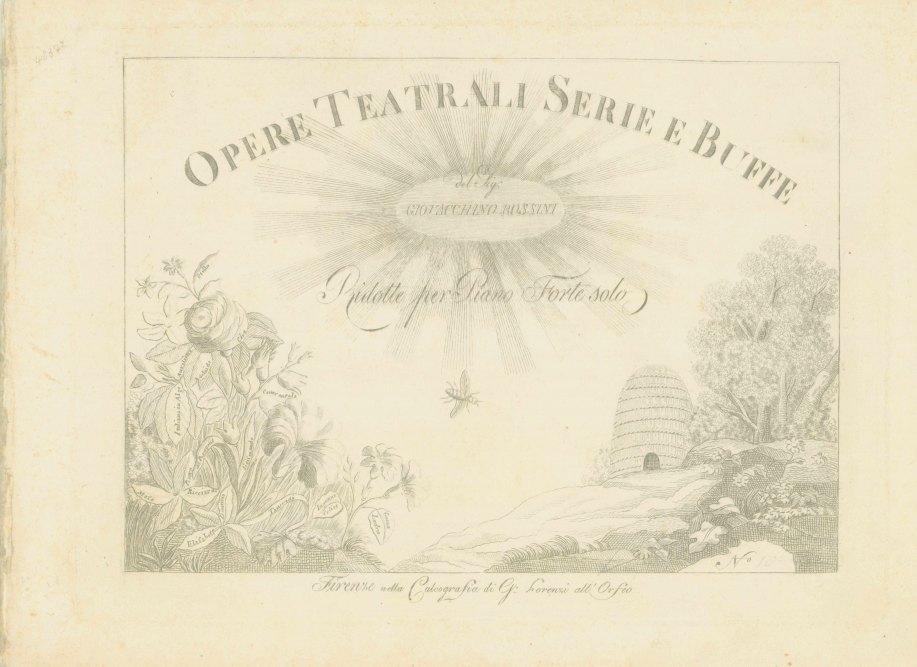 Rossini, Gioacchino (1792-1868) Opere Teatrali Serie e Buffe del Sig. Giovacchino Rossini. Ridotte per Piano Forte solo. [Includes two arrangements] G. Lorenzi: Firenze, [1820s]. Engraved. Oblong quarto. 14 pp. + 8 pp. Disbound but still sewn. Some bleedthrough, but otherwise a nice copy.MUS-14961 $60InquireTwo arrangements for piano, each with its own title page: the finale of La Gazza Ladra and "Lasciami non t'ascolto" from Tancredi. The arranger is not attributed.
Rossini, Gioacchino (1792-1868) Opere Teatrali Serie e Buffe del Sig. Giovacchino Rossini. Ridotte per Piano Forte solo. [Includes two arrangements] G. Lorenzi: Firenze, [1820s]. Engraved. Oblong quarto. 14 pp. + 8 pp. Disbound but still sewn. Some bleedthrough, but otherwise a nice copy.MUS-14961 $60InquireTwo arrangements for piano, each with its own title page: the finale of La Gazza Ladra and "Lasciami non t'ascolto" from Tancredi. The arranger is not attributed.Similar arrangements of Rossini's operas from this publisher are listed in WorldCat with publication dates in the 1820s. Unclear exactly when these two were issued.
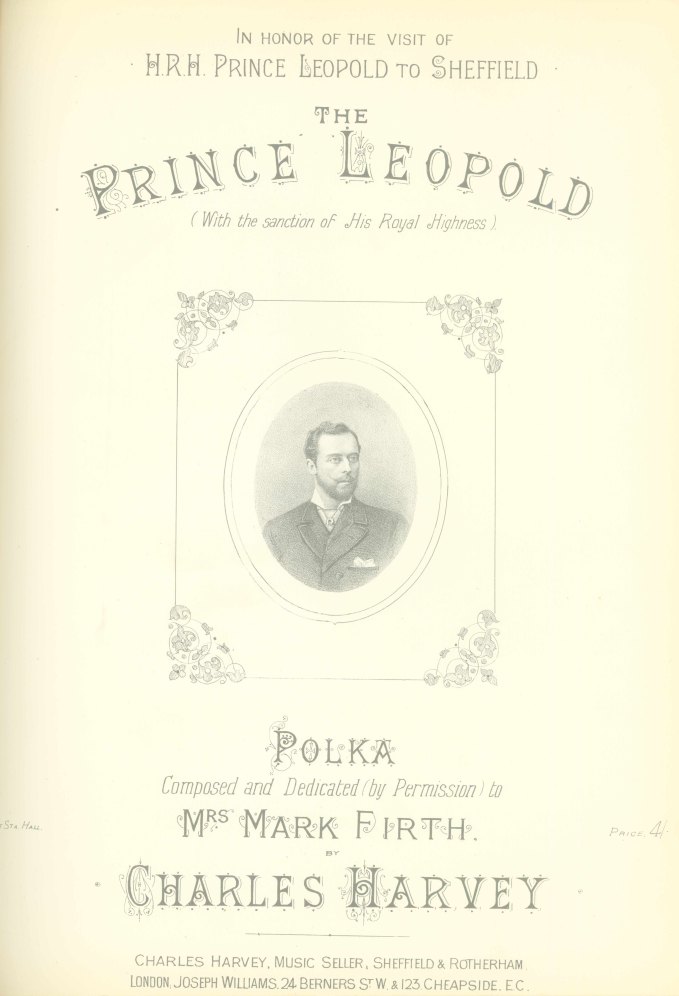 ROYAL SAMMELBAND - PERSONAL COPIES OF MUSIC DEDICATED TO THE DUKE AND DUCHESS OF ALBANY Quarto. With several color title pages. Purple linen spine with leather label & plain brown boards. All edges gilt. Front cover blindstamped with a crowned letter A and Music Dedicated to H. R. H. The Duke and Duchess of Albany. Boards a bit worn. Internally in excellent condition.MUS-15060 $400InquireA very attractive volume of 32 songs and incidental piano music dedicated to the Duke and Duchess of Albany by a host of composers, including but not limited to Arthur Sullivan, Berthold Tours, Louis von Esch, and several female composers.
ROYAL SAMMELBAND - PERSONAL COPIES OF MUSIC DEDICATED TO THE DUKE AND DUCHESS OF ALBANY Quarto. With several color title pages. Purple linen spine with leather label & plain brown boards. All edges gilt. Front cover blindstamped with a crowned letter A and Music Dedicated to H. R. H. The Duke and Duchess of Albany. Boards a bit worn. Internally in excellent condition.MUS-15060 $400InquireA very attractive volume of 32 songs and incidental piano music dedicated to the Duke and Duchess of Albany by a host of composers, including but not limited to Arthur Sullivan, Berthold Tours, Louis von Esch, and several female composers.The volume is compiled of the Duke and Duchess's personal copies. Several pieces are inscribed and signed by their composers: Ti saluto! by Mounsey Bartholomew; The Last Milestone by Henry Pontet; One Here, One Yonder by Annette Casson; and The Claremont and Claremont Valses by J.M. Falshaw (both Falshaw pieces inscribed without signature).
There are also manuscript copies of Gounod's Marche Nuptiale, which includes at the end God Save the Queen, and Theodor Adam's Man lebt nur einmal.
Finally, there are several songs to commemorate the passing of the Duke, who suffered an untimely death at age 30 in 1884: Where the Weary are at Rest, a Tribute to the Memory of H.R.H. Prince Leopold by John d'Esté; Lament, on the Death of His Royal Highness The Late Duke of Albany by Lillie Albrecht; and Not Dead but Sleeping by W. S. Bricknell.
Prince Leopold, Duke of Albany, was the eighth child and youngest son of Queen Victoria and Prince Albert. He married Princess Helena of Waldeck and Pyrmont in 1882, but their happy marriage was short-lived when he died of hemophilia just two years later.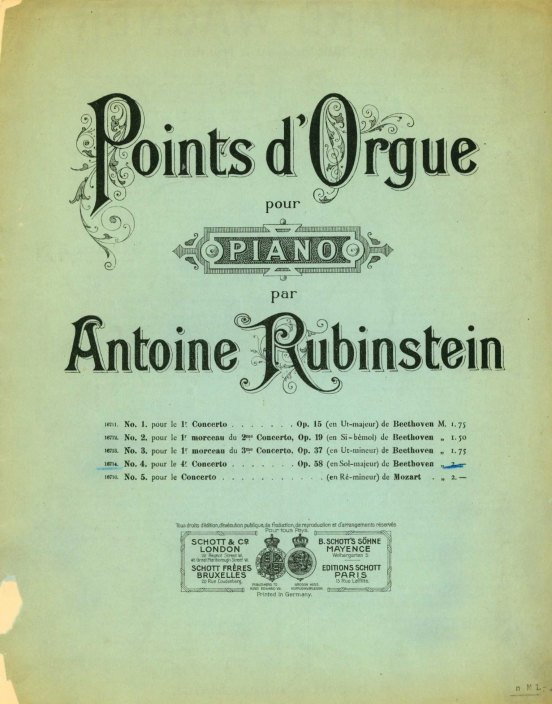 Rubinstein, Anton (1829-1894) Points d'Orgue pour le 4me. Concerto, Op. 58, de L. van Beethoven. B. Schott's Söhne: Mainz, [1862]. Pl.n: 16714. first edition. Large quarto. 14 + 1 (advertisement) pp. Original mint-colored wrapper (a little toned with a few chips to edges). Dealer stamp on title page. A few creases and a little edge wear. A very clean copy overall.MUS-07132 $85InquireRubinstein's cadenzas for Beethoven's Fourth Piano Concerto.
Rubinstein, Anton (1829-1894) Points d'Orgue pour le 4me. Concerto, Op. 58, de L. van Beethoven. B. Schott's Söhne: Mainz, [1862]. Pl.n: 16714. first edition. Large quarto. 14 + 1 (advertisement) pp. Original mint-colored wrapper (a little toned with a few chips to edges). Dealer stamp on title page. A few creases and a little edge wear. A very clean copy overall.MUS-07132 $85InquireRubinstein's cadenzas for Beethoven's Fourth Piano Concerto. Rubinstein, Anton (1829-1894) Trio für Pian, Violine und Violoncell. Op. 15. No. 1 in F. Neue, vom Componisten revidirte Ausgabe. Friedrich Hofmeister.: Leipzig, [1882, as per WorldCat]. Pl.n: 4942. Quarto. 47 pp. [pno score]; 9 pp. [vln]; 9 pp. [vlc]. Piano score with original paper wraps, just a little worn with tape reinforcement at spine. A nice, clean copy.MUS-15547 $85InquirePiano score and parts. This may be a second edition; the trio was first published in 1855.
Rubinstein, Anton (1829-1894) Trio für Pian, Violine und Violoncell. Op. 15. No. 1 in F. Neue, vom Componisten revidirte Ausgabe. Friedrich Hofmeister.: Leipzig, [1882, as per WorldCat]. Pl.n: 4942. Quarto. 47 pp. [pno score]; 9 pp. [vln]; 9 pp. [vlc]. Piano score with original paper wraps, just a little worn with tape reinforcement at spine. A nice, clean copy.MUS-15547 $85InquirePiano score and parts. This may be a second edition; the trio was first published in 1855. Rudolph, C.F. Cecilia Waltz A. Fiot / W. Dubois: Philadelphia / New York, 1848. Engraved. Quarto. 2 pp. Disbound. Light stains. Oveall a very nice copy.MUS-07134 $15Inquire
Rudolph, C.F. Cecilia Waltz A. Fiot / W. Dubois: Philadelphia / New York, 1848. Engraved. Quarto. 2 pp. Disbound. Light stains. Oveall a very nice copy.MUS-07134 $15Inquire- Ruiz de Ribayaz, Lucas (1626-1667) Los Guitarristas Lucas Ruiz de Ribayaz: Luz y Norte Musical. Transcription realizada con la colaboraciòn Maria-Rosa Calvo-Manzano Alpuerto: Madrid, 1982. Facsimile and transcription of the original Madrid 1677 edition. Quarto. 160 pp. of facsimile + 42 pp. of commentary (in Spanish) + 74pp. of transcription. Original d/j, red simulated leather. Top of spine a little bumped, covers slightly worn, otherwise excellent. FAC-10623 $300Inquire
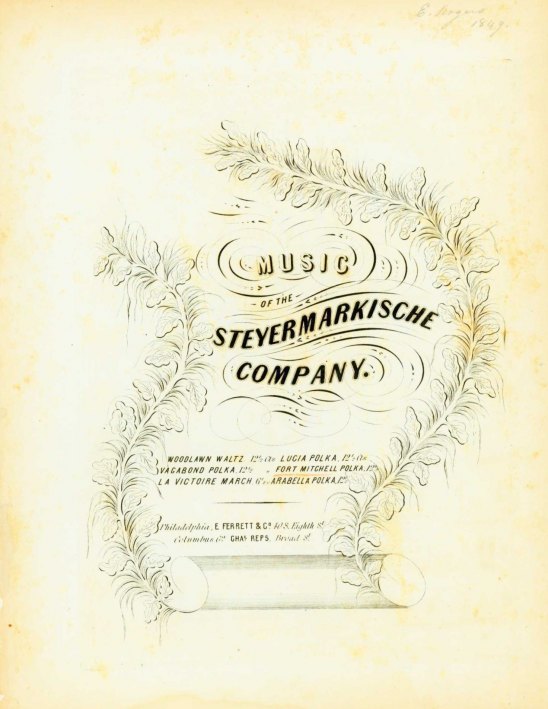 Rziha, Francis Music of the Steyermarkische Company. Fort Mitchell Polka Chas. Reps: Columbus, GA, 1849. Engraved. Quarto. 6 pp. Disbond; title page detached. Good condition. Foxing to title page. Water stain at bottom of all pages and small chips to bottom of last page (none affecting). Light bleed through.MUS-07135 $20InquireFrancis Rziha was the leader of the Steyermarkische Co.
Rziha, Francis Music of the Steyermarkische Company. Fort Mitchell Polka Chas. Reps: Columbus, GA, 1849. Engraved. Quarto. 6 pp. Disbond; title page detached. Good condition. Foxing to title page. Water stain at bottom of all pages and small chips to bottom of last page (none affecting). Light bleed through.MUS-07135 $20InquireFrancis Rziha was the leader of the Steyermarkische Co.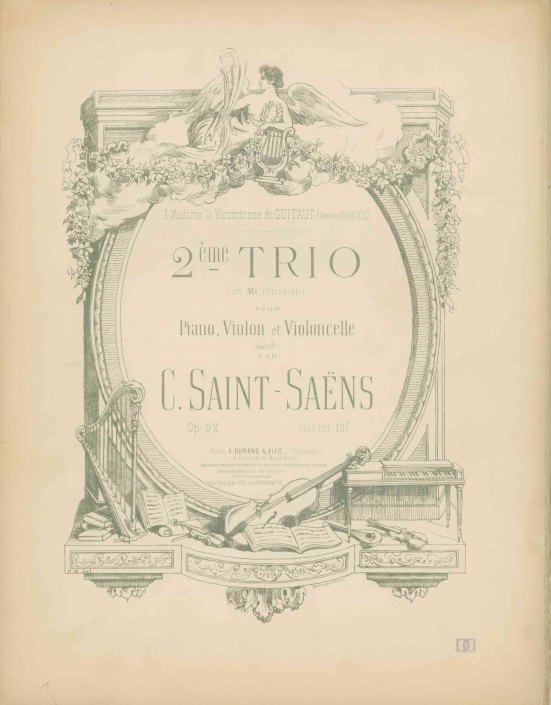 Saint-Saëns, Camille (1835-1921) Deuxième Trio (en Mi mineur) pour Piano, Violon et Violoncelle. Op. 92. A. Durand & Fils.: Paris, 1892. Pl.n: D. & F. 4552. Possible first edition. Quarto. 60 pp. [pno score]; 15 pp. [vln part]; 15 pp. [vlc part]. Piano score with original paper wraps. In very good condition. Piano score with some performance markings in first and second movements.MUS-15548 $125InquirePiano score and parts.
Saint-Saëns, Camille (1835-1921) Deuxième Trio (en Mi mineur) pour Piano, Violon et Violoncelle. Op. 92. A. Durand & Fils.: Paris, 1892. Pl.n: D. & F. 4552. Possible first edition. Quarto. 60 pp. [pno score]; 15 pp. [vln part]; 15 pp. [vlc part]. Piano score with original paper wraps. In very good condition. Piano score with some performance markings in first and second movements.MUS-15548 $125InquirePiano score and parts.With trimmed and detached wrappers in which all parts were likely originally sold.
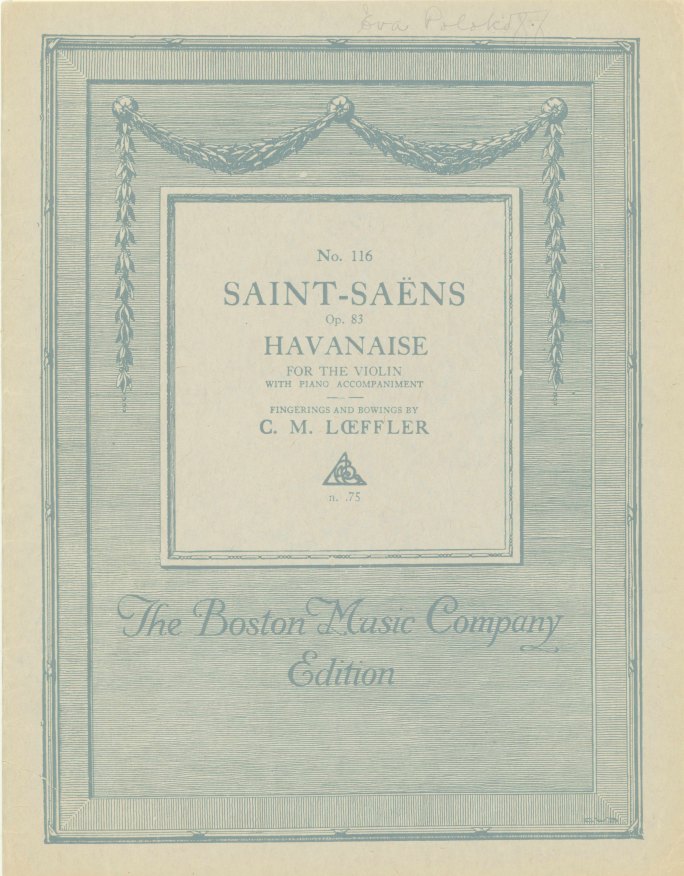 Saint-Saëns, Camille (1835-1921) Havanaise for the Violin with Piano Accompaniment. Op. 83. Fingers and Bowings by C. M. Lœffler. Boston Music Company: Boston, 1916. Pl.n: B.M.Co. 4590. Quarto. 7 pp. [vln part] + 15 pp. [pno part]. Original paper wrappers. Very minor tear to bottom left corner of front cover with signature of former owner at top. A few fingerings/bowings penciled in violin part. Otherwise a nice, crisp copy.MUS-06401 $35Inquire
Saint-Saëns, Camille (1835-1921) Havanaise for the Violin with Piano Accompaniment. Op. 83. Fingers and Bowings by C. M. Lœffler. Boston Music Company: Boston, 1916. Pl.n: B.M.Co. 4590. Quarto. 7 pp. [vln part] + 15 pp. [pno part]. Original paper wrappers. Very minor tear to bottom left corner of front cover with signature of former owner at top. A few fingerings/bowings penciled in violin part. Otherwise a nice, crisp copy.MUS-06401 $35Inquire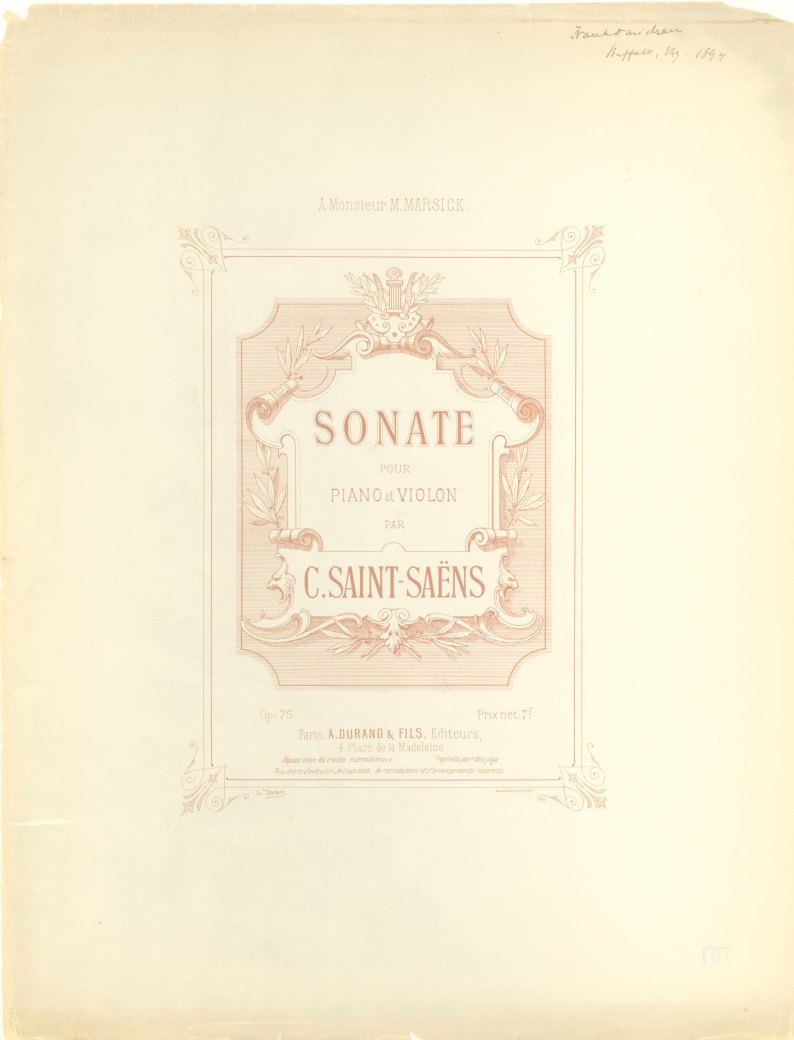 Saint-Saëns, Camille (1835-1921) Sonate pour Piano et Violon. Op. 75. Durand: Paris, [1885]. Pl.n: D. S. 3541. first edition. Large quarto. 15 pp. [vln part] + 39 pp. [pno part]. Cover a bit dusty with minor chips and signature of former owner at top. Cover and final blank detached. Minor wear to a few page edges. Otherwise clean and in good condition.MUS-06402 $125InquirePublication date based on plate number.
Saint-Saëns, Camille (1835-1921) Sonate pour Piano et Violon. Op. 75. Durand: Paris, [1885]. Pl.n: D. S. 3541. first edition. Large quarto. 15 pp. [vln part] + 39 pp. [pno part]. Cover a bit dusty with minor chips and signature of former owner at top. Cover and final blank detached. Minor wear to a few page edges. Otherwise clean and in good condition.MUS-06402 $125InquirePublication date based on plate number.- Salieri, Antonio (1750-1825) Falstaff ovvero Le tre burle: Opera in 3 atti. Nuova edizione neela revisione a cura di Eva Riccioli Orcchia. Libretto di Carlo Prospero de Franceschi. Piano Vocal Score. Manuscript facsimile Edizioni Musicale Otos: Florence, 1968. Large quarto. 480 pp. Ozalid reproduction. Paper wraps. Spine tips and edge of front cover a little chipped. Interior lightly and evenly sunned, but overall condition excellent. FAC-06144 $350Inquire
 Salomirsky, P. Il Faut Mourir Quand On Est Malheureux! Oblong quarto. 4 pp. Disbound and detached. Foxed, but otherwise in good condition.MUS-15250 $15InquireNo publishing information is provided for this little lamenting French song in F minor, the cover of which bears a large and clean lithograph of a stormy scene by nineteenth-century lithographer Karl Petrovic Beggrov.
Salomirsky, P. Il Faut Mourir Quand On Est Malheureux! Oblong quarto. 4 pp. Disbound and detached. Foxed, but otherwise in good condition.MUS-15250 $15InquireNo publishing information is provided for this little lamenting French song in F minor, the cover of which bears a large and clean lithograph of a stormy scene by nineteenth-century lithographer Karl Petrovic Beggrov.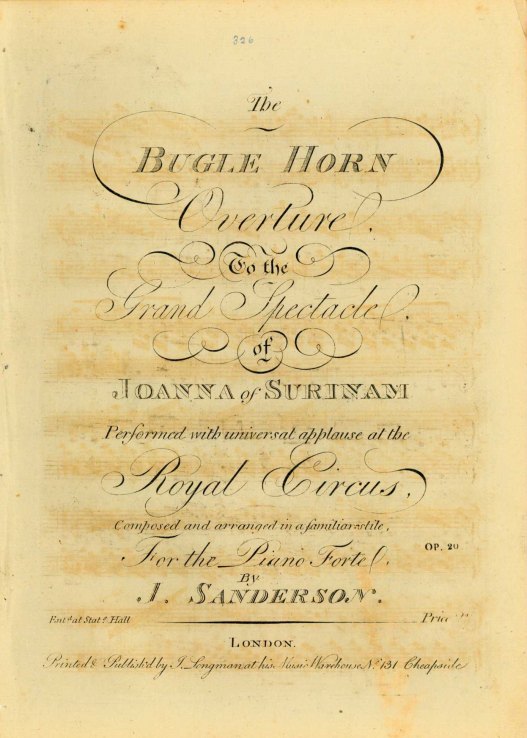 Sanderson, J. The Bugle Horn Overture, to the Grand Spectacle of Joanna of Surinam, Performed with universal applause at the Royal Circus, Composed and arranged in a familiar stile, for the Piano Forte. Op. 20. J[ohn] Longman: London, [ca 1801-1816]. Engraved. Quarto. 8 pp. Disbound. Overall in good condition. Last page detached with some toning. Ink transfer throughout. Manuscript pagination above printed pagination.MUS-07137 $35InquirePublished between 1801 and 1816, based on publisher's address.
Sanderson, J. The Bugle Horn Overture, to the Grand Spectacle of Joanna of Surinam, Performed with universal applause at the Royal Circus, Composed and arranged in a familiar stile, for the Piano Forte. Op. 20. J[ohn] Longman: London, [ca 1801-1816]. Engraved. Quarto. 8 pp. Disbound. Overall in good condition. Last page detached with some toning. Ink transfer throughout. Manuscript pagination above printed pagination.MUS-07137 $35InquirePublished between 1801 and 1816, based on publisher's address.- Sanderson, James (1769-1841) A Series of Popular Airs with Variations for the Violin with an Accompaniment for a Second Violin Composed and Dedicated to N. Mori, Esqre. by Ja. Sanderson, No. 2. Op. 53. [Kinloch of Kinloch] Clementi: London, [after 1821]. Pl.n: n.p.n. Folio. 6 + 2 pp. Pages browned with untrimmed tattered edges but broad margins leave musical text completely intact, title page attached with hinges, otherwise very good. MUS-06475 $100InquireTwo separate violin parts. Watermark: 1821. Sanderson was a violinist and conductor in the London theater who in 1812 adapted a Scottish folk melody for use with words from Sir Walter Scott's "Lady of the Lake" to create "Hail to the Chief." It was published in the US during the War of 1812 and gained some popularity then, but only later became defined as the official musical tribute to the US President, with different lyrics.
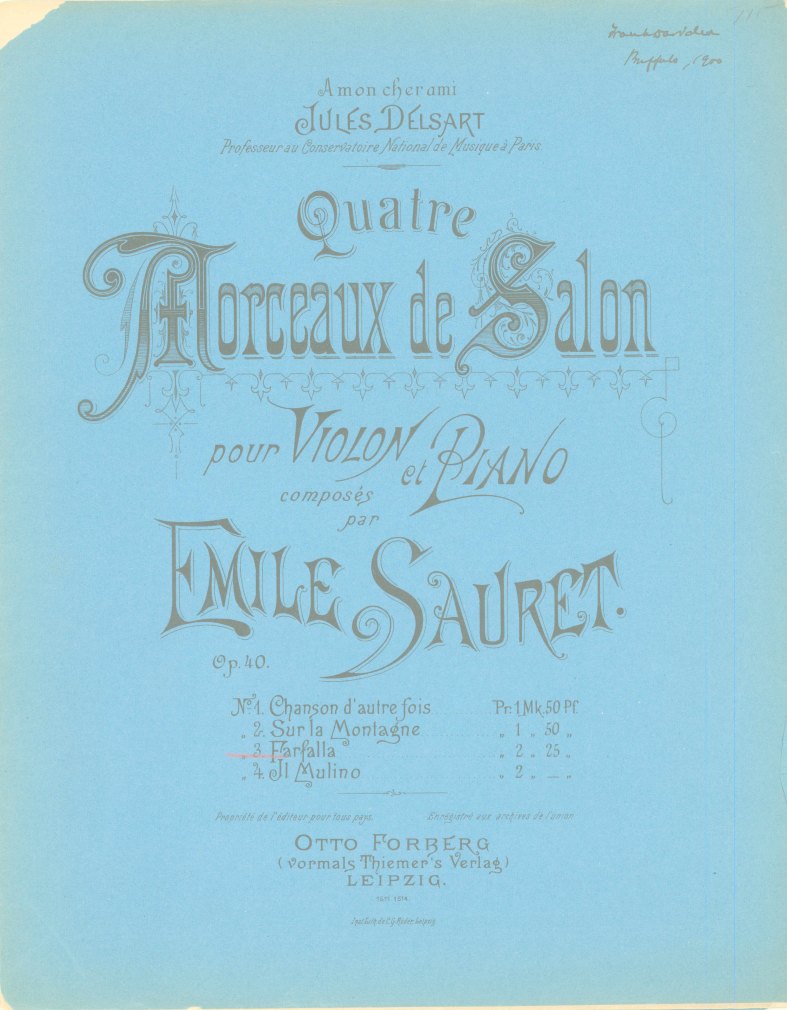 Sauret, Emile (1852-1920) Quatre Morceaux de Salon pour Violon et Piano. Op. 40, No. 3: Farfalla. Otto Forberg: Leipzig, [1889]. Pl.n: 1513. Apparent first edition. Quarto. 5 pp. [vln part] + 9 pp. [pno part]. Original blue paper wrappers (separating at spine with a few chips at edges and signature of former owner at front). Occasional pencilled marking in violin part, otherwise fine.MUS-06403 $60InquirePublication date based on plate number.
Sauret, Emile (1852-1920) Quatre Morceaux de Salon pour Violon et Piano. Op. 40, No. 3: Farfalla. Otto Forberg: Leipzig, [1889]. Pl.n: 1513. Apparent first edition. Quarto. 5 pp. [vln part] + 9 pp. [pno part]. Original blue paper wrappers (separating at spine with a few chips at edges and signature of former owner at front). Occasional pencilled marking in violin part, otherwise fine.MUS-06403 $60InquirePublication date based on plate number.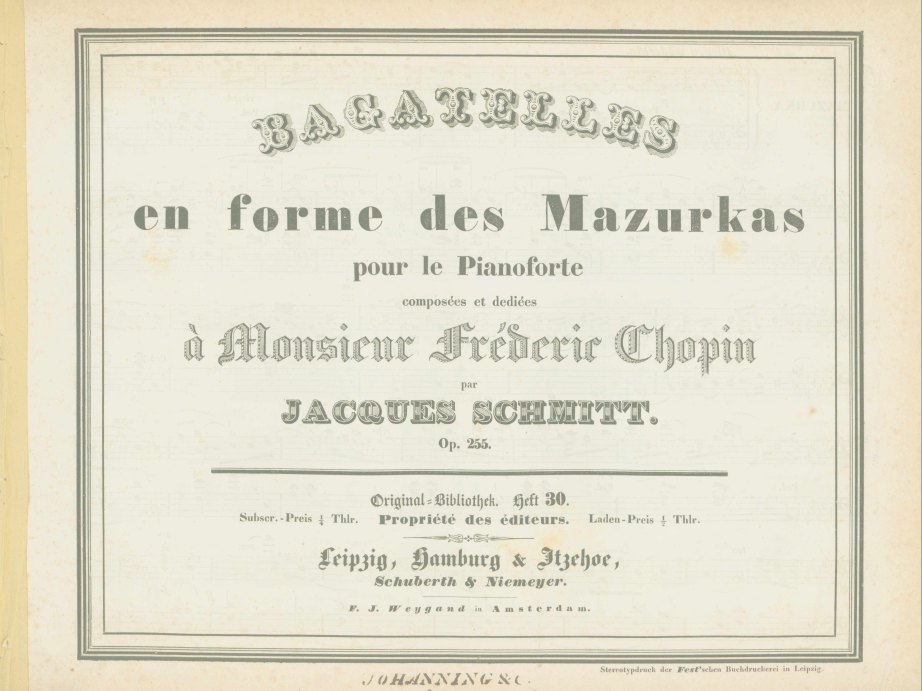 Schmitt, Jakob (Jacques) (1803-1853) Bagatelles en forme des Mazurkas pour le Pianoforte. Op. 255. Schuberth & Niemeyer: Leipzig, Hamburg & Itzehoe Pl.n: H. XXX. B. 1. Oblong quarto. 11 pp. Disbound. Paper tape at spine. Title page detached. A little foxing and spotting throughout, but overall fine.MUS-14922 $35InquirePublished between 1830 and 1839, based on publishing company name (Niemeyer was only part of Schuberth's business from 1830 to 1839).
Schmitt, Jakob (Jacques) (1803-1853) Bagatelles en forme des Mazurkas pour le Pianoforte. Op. 255. Schuberth & Niemeyer: Leipzig, Hamburg & Itzehoe Pl.n: H. XXX. B. 1. Oblong quarto. 11 pp. Disbound. Paper tape at spine. Title page detached. A little foxing and spotting throughout, but overall fine.MUS-14922 $35InquirePublished between 1830 and 1839, based on publishing company name (Niemeyer was only part of Schuberth's business from 1830 to 1839).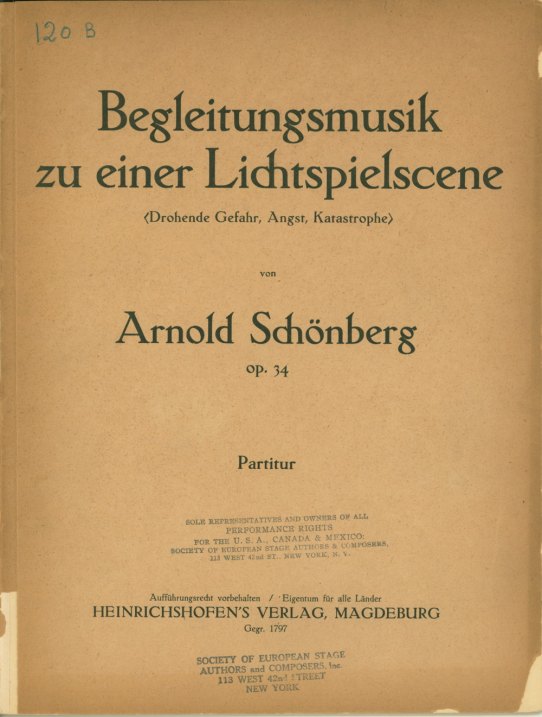 Schoenberg, Arnold (1874-1951) Begleitungsmusik zu einer Lichtspielscene, Op. 34. Partitur Heinrichshofen: Magdeburg, [1930, as per WorldCat]. Pl.n: Gegr. 1797. Apparent first edition. 46 pp. Stamped on front cover: "Society of European Stage/ Authors and Composers, Inc./113 West 42nd. St./ New York. Paper wraps. Covers detached and chipped along edges; inside clean and fine.MUS-09844 $125InquireAccompaniment to a Film Scene (Begleitmusik zu einer Lichtspielscene) is a short 10-minute work written in 1930, using Schoenberg's by then entrenched 12-tone technique. In 1929 Schoenberg was commissioned by the Heinrichshofen Verlag in Magdeburg to write film music but it appears that Schoenberg never complied with the instructions and the work remains music for an imaginary (silent) film sequence, although one using the suggested key words “Threatening Danger, Fear, Catastrophe,” which the composer uses as a subtitle. Although no film ever transpired, the work was premiered in 1930 in Berlin under the direction of Otto Klemperer and later received its American premiere at the Hollywood Bowl, under the direction of Nicolas Slonimsky.
Schoenberg, Arnold (1874-1951) Begleitungsmusik zu einer Lichtspielscene, Op. 34. Partitur Heinrichshofen: Magdeburg, [1930, as per WorldCat]. Pl.n: Gegr. 1797. Apparent first edition. 46 pp. Stamped on front cover: "Society of European Stage/ Authors and Composers, Inc./113 West 42nd. St./ New York. Paper wraps. Covers detached and chipped along edges; inside clean and fine.MUS-09844 $125InquireAccompaniment to a Film Scene (Begleitmusik zu einer Lichtspielscene) is a short 10-minute work written in 1930, using Schoenberg's by then entrenched 12-tone technique. In 1929 Schoenberg was commissioned by the Heinrichshofen Verlag in Magdeburg to write film music but it appears that Schoenberg never complied with the instructions and the work remains music for an imaginary (silent) film sequence, although one using the suggested key words “Threatening Danger, Fear, Catastrophe,” which the composer uses as a subtitle. Although no film ever transpired, the work was premiered in 1930 in Berlin under the direction of Otto Klemperer and later received its American premiere at the Hollywood Bowl, under the direction of Nicolas Slonimsky.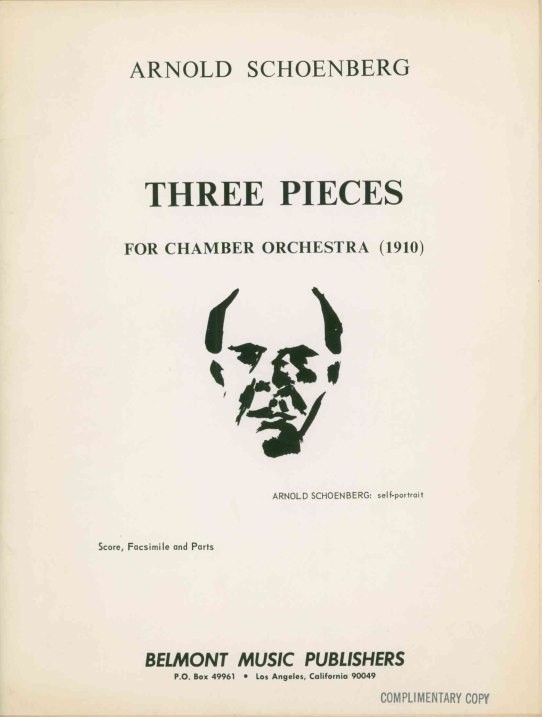 Schoenberg, Arnold (1874-1951) Three Pieces for Chamber Orchestra (1910). Score, Fascimile and Parts. Belmont Music Publishers: Los Angeles, 1962. first edition. Small quarto. 13 pp. [score + facsimile]; all parts 1 p. each. As new with Complimentary Copy stamp on front wrapper, not affecting.MUS-07352 $150Inquire
Schoenberg, Arnold (1874-1951) Three Pieces for Chamber Orchestra (1910). Score, Fascimile and Parts. Belmont Music Publishers: Los Angeles, 1962. first edition. Small quarto. 13 pp. [score + facsimile]; all parts 1 p. each. As new with Complimentary Copy stamp on front wrapper, not affecting.MUS-07352 $150Inquire